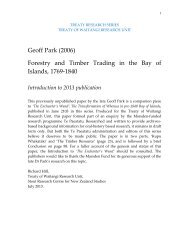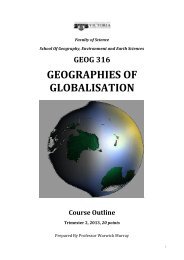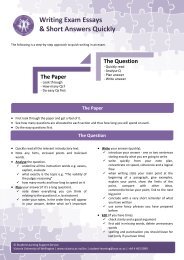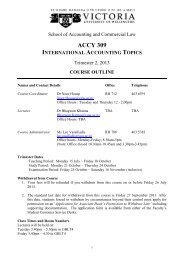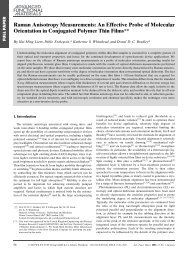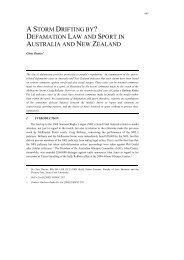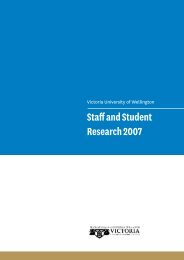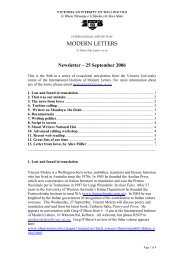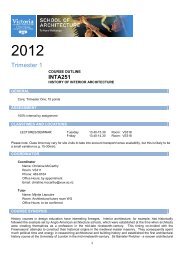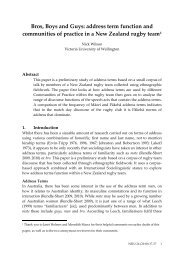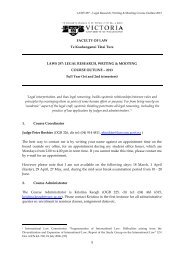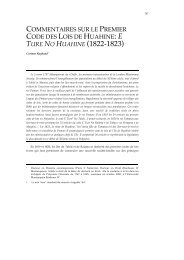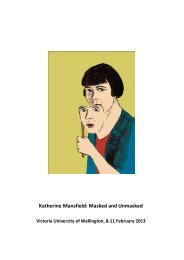The Diasporic Imaginary and the Indian Diaspora - Victoria ...
The Diasporic Imaginary and the Indian Diaspora - Victoria ...
The Diasporic Imaginary and the Indian Diaspora - Victoria ...
Create successful ePaper yourself
Turn your PDF publications into a flip-book with our unique Google optimized e-Paper software.
A Personal Record of My Garden of Reflections<br />
<strong>The</strong> <strong>Diasporic</strong> <strong>Imaginary</strong><br />
<strong>and</strong> <strong>the</strong> <strong>Indian</strong> <strong>Diaspora</strong><br />
Vijay Mishra<br />
Murdoch University<br />
Asian Studies Institute Occasional Lecture 2
Vijay Vijay Mishra Mishra Mishra is Professor of English Literature at Murdoch<br />
University, Perth. He graduated from <strong>Victoria</strong> University of<br />
Wellington in 1967. This was followed, via Christchurch Teachers’<br />
College, Macquarie <strong>and</strong> Sydney, by doctorates from ANU <strong>and</strong><br />
Oxford. Among his publications are: Dark Side of <strong>the</strong> Dream:<br />
Australian Literature <strong>and</strong> <strong>the</strong> Postcolonial Mind (with Bob<br />
Hodge), <strong>The</strong> Gothic Sublime, Devotional Poetics <strong>and</strong> <strong>the</strong> <strong>Indian</strong><br />
Sublime, Bollywood Cinema: Temples of Desire. His most recent<br />
essay (with Bob Hodge) “What was Postcolonialism?” appears in<br />
New Literary History 36.3 (Summer 2005): 375-402. He has finally<br />
completed his book on <strong>the</strong> <strong>Diasporic</strong> <strong>Imaginary</strong>. He plays <strong>the</strong><br />
<strong>Indian</strong> harmonium, is a Beatles fan <strong>and</strong> reads Sanskrit.<br />
This lecture was given at <strong>Victoria</strong> University of Wellington on<br />
29 August 2005<br />
ISSN: 1174-5991<br />
ISBN: 0-473-10651-5<br />
ISBN (PDF): 978-1-877446-04-7<br />
Series Editor: Dr Stephen Epstein<br />
Desktop publisher: Laila Faisal<br />
Printed: November 2005<br />
PDF produced May 2007<br />
Asian Studies Institute<br />
<strong>Victoria</strong> University of Wellington<br />
PO Box 600<br />
Wellington, New Zeal<strong>and</strong><br />
Telephone +64 4 4635098<br />
Fax +64 4 463 5291<br />
Email asi@vuw.ac.nz<br />
Web www.vuw.ac.nz/asianstudies
<strong>The</strong> <strong>Diasporic</strong> <strong>Imaginary</strong> <strong>and</strong> <strong>the</strong> <strong>Indian</strong> <strong>Diaspora</strong><br />
<strong>The</strong> <strong>Diasporic</strong> <strong>Imaginary</strong><br />
<strong>and</strong> <strong>the</strong> <strong>Indian</strong> <strong>Diaspora</strong>*<br />
Vijay Mishra<br />
Murdoch University<br />
“All diasporas are unhappy, but every diaspora is unhappy in its<br />
own way” (Mishra 1996: 189). <strong>Diaspora</strong>s refer to people who do not<br />
feel comfortable with <strong>the</strong>ir non-hyphenated identities as indicated<br />
on <strong>the</strong>ir passports. <strong>Diaspora</strong>s are people who would want to<br />
explore <strong>the</strong> meaning of <strong>the</strong> hyphen, but perhaps not press <strong>the</strong><br />
hyphen too far for fear that this would lead to massive communal<br />
schizophrenia. <strong>The</strong>y are precariously lodged within an episteme of<br />
real or imagined displacements, self-imposed sense of exile; <strong>the</strong>y<br />
are haunted by spectres, by ghosts arising from within that<br />
encourage irredentist or separatist movements. <strong>Diaspora</strong>s are both<br />
celebrated (by late/post modernity) <strong>and</strong> maligned (by early<br />
modernity). But we need to be a little cautious, a little wary of ei<strong>the</strong>r<br />
position. Celebrating diasporas as <strong>the</strong> exemplary condition of late<br />
modernity – diasporas as highly democratic communities for whom<br />
domination <strong>and</strong> territoriality are not <strong>the</strong> preconditions of<br />
“nationhood” – is a not uncommon refrain. In <strong>the</strong> late modern<br />
celebratory argument on behalf of diasporas, diasporic communities<br />
are said to occupy a border zone where <strong>the</strong> most vibrant kinds of<br />
interactions take place <strong>and</strong> where ethnicity <strong>and</strong> nation are kept<br />
separate. In this argument, diasporas are fluid, ideal, social<br />
formations happy to live wherever <strong>the</strong>re is an international airport<br />
<strong>and</strong> st<strong>and</strong> for a longer, much admired, historical process.<br />
*I wish to dedicate this paper to <strong>the</strong> late Boyd Anderson, with whom I shared<br />
many of my anxieties as a student in Weir House, <strong>Victoria</strong> University of<br />
Wellington 1964-66. Boyd last contacted me from Nadi on his way to Berkeley in<br />
1968. I had returned to Fiji <strong>and</strong> was teaching at a high school <strong>the</strong>re. Little did Boyd<br />
realize when he rang me that my school was on ano<strong>the</strong>r isl<strong>and</strong> <strong>and</strong> I couldn’t<br />
possibly reach him during his hours in transit. Years later I heard from Miles<br />
Fairburn, now Professor of History at <strong>the</strong> University of Canterbury, that Boyd had<br />
died young <strong>and</strong> in tragic circumstances.<br />
I wish to thank Stephen Epstein for inviting me to VUW to deliver this lecture <strong>and</strong><br />
for his editorial work on <strong>the</strong> published version.<br />
1
Vijay Mishra<br />
<strong>The</strong> tension between this position <strong>and</strong> <strong>the</strong> earlier modern<br />
reactionary reading is evident in <strong>the</strong> classic Hollywood film,<br />
Casablanca (1942). In it, as Ca<strong>the</strong>rine Portuges has pointed out, <strong>the</strong><br />
opening sequence presents <strong>the</strong> spectator with “polyglot crowds of<br />
hopeful refugees awaiting <strong>the</strong> miracle of an exit visa to a better<br />
world” (50). Placed against Hollywood’s own tendency to produce a<br />
cultural product that is homogeneous <strong>and</strong> unproblematically<br />
“American,” <strong>the</strong> “irreducible particularity of <strong>the</strong>ir [<strong>the</strong> characters’]<br />
ethnic <strong>and</strong> regional voices” (53) suggests that Michael Curtiz, <strong>the</strong><br />
film’s director <strong>and</strong> himself a Hungarian émigré, was introducing a<br />
discrepant diasporic narrative, a discordant, dialogic eruption, into<br />
<strong>the</strong> film as a statement about diasporic labour in <strong>the</strong> formation of<br />
Hollywood filmic practice <strong>and</strong> about alternative, unhappy,<br />
irreconcilable narratives embedded in voices that Casablanca dare<br />
not interrogate. After all, it is in Casablanca that Rick Blaine<br />
(Humphrey Bogart) when asked about his nationality replies,<br />
without any ironic intent, “I’m a drunkard.”<br />
<strong>The</strong> narrative of Casablanca posits escape to liberty as <strong>the</strong> universal<br />
ideal, even if <strong>the</strong> ideology is encased in a mushy romance. Ideology<br />
by virtue of its connection with <strong>the</strong> aes<strong>the</strong>tics of romance (which is<br />
how <strong>the</strong> film Casablanca has been popularly received) deflects a<br />
fundamental aspect of diaspora: its irreducible complexity at <strong>the</strong><br />
level of lived social <strong>and</strong> political expression. <strong>The</strong> point, hidden from<br />
<strong>the</strong> film’s diegesis, is that diasporas have a progressivist as well as a<br />
reactionary streak in <strong>the</strong>m. Both forms of this “streak” centre on <strong>the</strong><br />
idea of one’s “homel<strong>and</strong>” as very real spaces from which alone a<br />
certain level of redemption is possible. Homel<strong>and</strong> is <strong>the</strong> desh (in<br />
Hindi) against which all <strong>the</strong> o<strong>the</strong>r l<strong>and</strong>s are foreign or videsh. When<br />
not presented in this “real” sense, homel<strong>and</strong> exists as an absence<br />
that acquires surplus meaning by <strong>the</strong> fact of diaspora so that Sikhs<br />
in Vancouver <strong>and</strong> Sri Lankan Tamils in Toronto clamour for a<br />
homel<strong>and</strong> (Khalistan, Tamil Eelam) or, in some quarters, Muslims<br />
seek a pan-Islamic utopia in <strong>the</strong> European heartl<strong>and</strong>. It is not<br />
unusual for <strong>the</strong> two versions (<strong>the</strong> physical <strong>and</strong> <strong>the</strong> mental) to be<br />
collapsed into an ahistorical past going back to antiquity. We need<br />
to make an important qualification though. This reading of <strong>the</strong><br />
homel<strong>and</strong> must be placed alongside ano<strong>the</strong>r truth about diasporas:<br />
as a general rule – <strong>and</strong> <strong>the</strong> establishment of a Jewish homel<strong>and</strong> is<br />
<strong>the</strong> exception <strong>and</strong> not <strong>the</strong> rule – diasporas do not return to <strong>the</strong>ir<br />
homel<strong>and</strong>. Throughout <strong>the</strong> dark years of South African apar<strong>the</strong>id,<br />
few <strong>Indian</strong>s (<strong>the</strong> Mahatma is <strong>the</strong> notable exception) returned to<br />
2
<strong>The</strong> <strong>Diasporic</strong> <strong>Imaginary</strong> <strong>and</strong> <strong>the</strong> <strong>Indian</strong> <strong>Diaspora</strong><br />
India. Nei<strong>the</strong>r have Fiji <strong>Indian</strong>s returned, in spite of Fiji’s current<br />
policy of institutionalized racism.<br />
<strong>The</strong> intimations of <strong>the</strong>ory are present in <strong>the</strong> outline of issues given<br />
above. Here I wish to reprise part of <strong>the</strong> argument, rework <strong>the</strong><br />
archive, narrow <strong>the</strong> terms <strong>and</strong>, above all, offer a <strong>the</strong>oretical<br />
framework for <strong>the</strong> study of diasporas. <strong>The</strong> task is not made any<br />
easier, because diaspora is itself part of some o<strong>the</strong>r “cover” field<br />
(perhaps postcolonial or multicultural studies) in a segmentation<br />
that is problematic. <strong>The</strong> placement of diaspora in this larger<br />
“cover” field is for many historians of diaspora a recent <strong>the</strong>oretical<br />
issue, because not too long ago <strong>the</strong> study of diaspora, <strong>and</strong> <strong>the</strong><br />
definition of <strong>the</strong> term itself, was relatively straightforward. Both,<br />
analysis <strong>and</strong> definition, implied a gr<strong>and</strong> narrative of <strong>the</strong> history of<br />
<strong>the</strong> Jewish people. To invoke diaspora presupposed a prior<br />
underst<strong>and</strong>ing of a linear narrative of dispersal <strong>and</strong> return of <strong>the</strong><br />
original People of <strong>the</strong> Book. Depending upon one’s point of view,<br />
this narrative could be rendered in epic terms or in terms of <strong>the</strong><br />
uprooted, aimless w<strong>and</strong>erer in search of home. In <strong>the</strong> latter<br />
exegesis, Jewish history was represented through narratives of<br />
retribution <strong>and</strong> loss symbolized, at least in non-Jewish narratives,<br />
through <strong>the</strong> iconography of a w<strong>and</strong>erer or wayfarer whom even<br />
God had rejected. Although Charles Maturin never explicitly refers<br />
to <strong>the</strong> Jewish experience, most readers of his classic Gothic work<br />
Melmoth <strong>the</strong> W<strong>and</strong>erer (1820) have sensed that Maturin here uses <strong>the</strong><br />
Jewish experience as his unspeakable intertext. In <strong>the</strong> Qur’an that<br />
history is presented as a failure by <strong>the</strong> Jews to uphold a primal<br />
contract between man <strong>and</strong> God.<br />
When we turn to descriptive predication, that is, definitions,<br />
“diaspora” turns out to be a very culture-specific term. <strong>The</strong> Oxford<br />
English Dictionary refers quite explicitly to John vii, 35 (“<strong>the</strong><br />
dispersion; ... <strong>the</strong> whole body of Jews living dispersed among <strong>the</strong><br />
Gentiles after <strong>the</strong>ir Captivity”) to make <strong>the</strong> connection clear. <strong>The</strong><br />
OED, with its characteristic homage to <strong>the</strong> written word, locates <strong>the</strong><br />
first use of <strong>the</strong> term in Deuteronomy xxviii, 25 where we find: “thou<br />
shalt be a diaspora (or dispersion) in all kingdoms of <strong>the</strong> earth.” <strong>The</strong><br />
recent opening up of <strong>the</strong> word to signify <strong>the</strong> lives of “any group<br />
living in displacement” (Clifford 1994: 310) is a phenomenon that<br />
probably marks a postmodern move to dismantle a logocentric <strong>and</strong><br />
linear view of human affairs that connected narratives <strong>and</strong><br />
experiences to specific races <strong>and</strong> to origins: <strong>the</strong> model here was that<br />
3
Vijay Mishra<br />
of historical lexicography, of which <strong>the</strong> sublime example is <strong>the</strong> OED<br />
itself. 1<br />
<strong>The</strong> diasporic imaginary is a term I use to refer to any ethnic enclave<br />
in a nation-state that defines itself, consciously, unconsciously or<br />
through self-evident or implied political coercion, as a group that<br />
lives in displacement. 2 I use <strong>the</strong> word “imaginary” in both its<br />
original Lacanian sense (linked to <strong>the</strong> mirror stage of <strong>the</strong> ego, <strong>and</strong><br />
<strong>the</strong>refore characterized by a residual narcissism, resemblance <strong>and</strong><br />
homeomorphism 3 ) <strong>and</strong> in its more flexible current usage, as found<br />
in <strong>the</strong> works of Slavoj •i•ek. •i•ek defines <strong>the</strong> imaginary as <strong>the</strong><br />
state of “identification with <strong>the</strong> image in which we appear likeable<br />
to ourselves, with <strong>the</strong> image representing “ ‘what we would like to<br />
be’ ” (1989:105). •i•ek makes this point with reference to <strong>the</strong><br />
question one asks <strong>the</strong> hysteric: not “What is his object of desire?”<br />
but “Where does he desire from?” (•i•ek 1989: 187). In a subsequent<br />
application of this <strong>the</strong>ory to <strong>the</strong> nation itself, •i•ek connects <strong>the</strong> idea<br />
of what he calls <strong>the</strong> “Nation Thing” to its citizens’ imaginary<br />
identification with it. In this astute extension of <strong>the</strong> argument, <strong>the</strong><br />
“nation” (as <strong>the</strong> “Thing” in Heideggerian parlance that “presences”<br />
itself 4 ) is accessible to a particular group of people of itself because<br />
it (<strong>the</strong> group) needs no particular verification of this “Thing” called<br />
“Nation” (1993: 210-212). For this group <strong>the</strong> “nation” simply is<br />
(beyond any kind of symbolization); it is more than just an<br />
imagined community, even if it is constructed out of fantasies about<br />
a particular way of life that may be enjoyed by a particular<br />
community or race. <strong>The</strong> “way of life,” which may be defined by any<br />
number of things: pub culture, sportsmanship (rugby in New<br />
Zeal<strong>and</strong> is a classic case), capacity to live life fully, liberal values,<br />
non-negotiable connections with <strong>the</strong> l<strong>and</strong>, or something totally<br />
nebulous, which has meaning only when declared as an absence<br />
(“Why can’t <strong>the</strong>y be like us?”), is seen to come under threat from <strong>the</strong><br />
O<strong>the</strong>r (multicultural community, diaspora), since <strong>the</strong> latter has ways<br />
of enjoying <strong>the</strong> Nation that do not necessarily mirror <strong>the</strong> forms of<br />
<strong>the</strong> nation’s enjoyment of itself. Nor do <strong>the</strong>se alternative forms of<br />
enjoyment correspond to how members of <strong>the</strong> dominant<br />
community would like <strong>the</strong> nation to be (as a reflection of <strong>the</strong>ir own<br />
selves). Racist phobia, •i•ek suggests, arises out of a proprietary<br />
sense of enjoyment of <strong>the</strong> “Nation Thing” that is <strong>the</strong> exclusive<br />
property of a given group, community or race. <strong>The</strong> politics of many<br />
right-wing parties (Jean-Marie Le Pen’s National Front in France,<br />
4
<strong>The</strong> <strong>Diasporic</strong> <strong>Imaginary</strong> <strong>and</strong> <strong>the</strong> <strong>Indian</strong> <strong>Diaspora</strong><br />
Pauline Hanson’s One Nation in Australia, Fijian nationalist parties)<br />
grew straight out of <strong>the</strong>ir racist phobia of (visible) minorities, both<br />
indigenous <strong>and</strong> diasporic (as in many settler nations), <strong>and</strong> diasporic<br />
(as in Fiji). <strong>The</strong> current anti-Muslim nationalist rhetoric in large<br />
parts of <strong>the</strong> world (Western <strong>and</strong> non-Western) is ano<strong>the</strong>r version of<br />
<strong>the</strong> phobia: what if <strong>the</strong>se hijab-wearing women are really enjoying<br />
<strong>the</strong>ir diasporic lives amidst us, <strong>and</strong> constructing <strong>the</strong> nation “O<strong>the</strong>rwise”?<br />
But •i•ek is not speaking in <strong>the</strong> abstract about this “Thing” called<br />
<strong>the</strong> nation. Drawing on Lacan’s definitions of “enjoyment” •i•ek<br />
attempts something ra<strong>the</strong>r different: he brings a corporeal element<br />
to definitions of <strong>the</strong> nation-state so that <strong>the</strong> nation is more than just<br />
a structure of feeling, an “imagined” construct, without any<br />
foundation in <strong>the</strong> real. Here is •i•ek’s crucial qualification made<br />
with an eye to definitions of <strong>the</strong> nation that have emerged in <strong>the</strong><br />
wake of Benedict Anderson’s influential work:<br />
To emphasize in a “deconstructionist” mode that Nation is not a<br />
biological or transhistorical fact but a contingent discursive<br />
construction, an overdetermined result of textual practices, is thus<br />
misleading: such an emphasis overlooks <strong>the</strong> remainder of some<br />
real, nondiscursive kernel of enjoyment which must be present for<br />
<strong>the</strong> Nation qua discursive entity-effect to achieve its ontological<br />
consistency. (1993: 202)<br />
If <strong>the</strong> enjoyment of <strong>the</strong> Nation Thing is <strong>the</strong> property of a specific<br />
community, <strong>the</strong>n <strong>the</strong> O<strong>the</strong>r is always seen as someone who wishes<br />
to “steal [<strong>the</strong> nation’s] enjoyment” (203). But <strong>the</strong> fact remains that, in<br />
this imputation to <strong>the</strong> O<strong>the</strong>r of a property that we possess (<strong>and</strong><br />
“we” here refers to those of us who own <strong>the</strong> foundational narrative<br />
of <strong>the</strong> nation), we repress <strong>the</strong> “traumatic fact that we never possessed<br />
what was allegedly stolen from us” (203). Enjoyment is <strong>the</strong>refore<br />
always of <strong>the</strong> “imaginary” <strong>and</strong> we continue to impute to <strong>the</strong> O<strong>the</strong>r<br />
what we ourselves wish to enjoy. In o<strong>the</strong>r words, <strong>the</strong> fantasies of<br />
our own enjoyment return to us once we have, negatively, imputed<br />
<strong>the</strong> same to <strong>the</strong> O<strong>the</strong>r. In this respect, diaspora as O<strong>the</strong>r has an<br />
important function to play in <strong>the</strong> construction of <strong>the</strong> fantasies of <strong>the</strong><br />
nation-state as a Thing to be “enjoyed.”<br />
•i•ek, it must be said, constructs his argument with reference to <strong>the</strong><br />
disintegration of <strong>the</strong> East European communist bloc as his test case.<br />
Here <strong>the</strong> argument is that <strong>the</strong> rise of nationalisms in Eastern Europe<br />
mirrors a democratic process that, in <strong>the</strong> West, has lost all its<br />
5
Vijay Mishra<br />
original vigour <strong>and</strong> excitement. <strong>The</strong>se emergent nation-states as<br />
“O<strong>the</strong>r” give back to <strong>the</strong> West its original democratic message in <strong>the</strong><br />
typically Lacanian form of <strong>the</strong> speaker getting back from <strong>the</strong><br />
“addressee his own message in its true, inverted form” (208). In<br />
diasporas, <strong>the</strong>n, <strong>the</strong> nation-state sees <strong>the</strong> loss of an ideal, <strong>the</strong> loss of<br />
its own organic connection to <strong>the</strong> Thing, which it had always taken<br />
for granted. <strong>Diaspora</strong>s signify a Gesellschaft, an alienated society<br />
without any “organic laws,” against <strong>the</strong> nation-state’s own<br />
Gemeinschaft or “traditional, organically linked community” (211).<br />
<strong>The</strong> nation-state sees in diasporas reflections of its own past, its<br />
own earlier migration patterns, its own traumatic moments, <strong>and</strong> its<br />
memories of settlement. In <strong>the</strong> extended form of this argument, it is<br />
<strong>the</strong> absence of diasporic enjoyment of <strong>the</strong> Nation Thing in <strong>the</strong><br />
dominant group itself (<strong>and</strong> which enjoyment is <strong>the</strong> presumption<br />
upon which <strong>the</strong> nation-state itself is based) that gives rise to <strong>the</strong><br />
exclusion of diasporas from <strong>the</strong> national imaginary. 5 <strong>The</strong><br />
<strong>the</strong>orization of this fact remains incomplete since <strong>the</strong> psychology<br />
that underlies <strong>the</strong> enjoyment, an enjoyment ultimately predicated<br />
upon melancholia <strong>and</strong> loss, is never fully understood. <strong>The</strong> effects of<br />
<strong>the</strong> enjoyment are, however, clear enough. It is <strong>the</strong> diasporic<br />
enjoyment of <strong>the</strong> Nation Thing absent among <strong>the</strong> “proprietors” of<br />
<strong>the</strong> nation that gives rise to a range of responses, chief among <strong>the</strong>m<br />
racist exclusion <strong>and</strong> cultural denigration, that in some sense<br />
attenuate, or even deflect, a psychology that underlies <strong>the</strong> (lost)<br />
enjoyment of <strong>the</strong> nation by <strong>the</strong> dominant community. 6<br />
It follows, <strong>the</strong>n, that diasporas are embedded in nation-states that<br />
are already a “Thing” created out of a specific kind of (lapsed)<br />
enjoyment of it. For <strong>the</strong> dominant citizenry this “enjoyment” is a<br />
matter of retrospect, <strong>and</strong> exists in as much as it is owned <strong>and</strong><br />
possessed by <strong>the</strong> dominant citizenry. For <strong>the</strong> latter, diasporas must<br />
have a homel<strong>and</strong> since only upon this presumption can <strong>the</strong><br />
dominant group (or community or citizenry) define itself as a<br />
homogeneous entity. 7 Indeed, homel<strong>and</strong> as “[a] fantasy structure,<br />
[a] scenario, through which society perceives itself as a<br />
homogeneous entity” (Salecl 1994: 15) 8 is predicated on <strong>the</strong><br />
construction of desire around a particularly traumatic event. <strong>The</strong><br />
fantasy of <strong>the</strong> homel<strong>and</strong> is <strong>the</strong>n linked, in <strong>the</strong> case of <strong>the</strong> diaspora,<br />
to that recollected trauma that st<strong>and</strong>s for <strong>the</strong> sign of having been<br />
wrenched from one’s mo<strong>the</strong>r (fa<strong>the</strong>r) l<strong>and</strong>. <strong>The</strong> sign of trauma may<br />
be <strong>the</strong> “[middle] passage” of slave trade or <strong>Indian</strong> indenture. <strong>The</strong><br />
“real” nature of <strong>the</strong> disruption is, however, not <strong>the</strong> point at issue<br />
6
<strong>The</strong> <strong>Diasporic</strong> <strong>Imaginary</strong> <strong>and</strong> <strong>the</strong> <strong>Indian</strong> <strong>Diaspora</strong><br />
here; what is clear is that <strong>the</strong> moment of “rupture” is<br />
transformed into a trauma around an absence that, because it<br />
cannot be fully symbolized, becomes part of <strong>the</strong> fantasy itself.<br />
<strong>The</strong> Ukrainian famine for <strong>the</strong> Ukrainian diaspora, <strong>the</strong> Turkish<br />
massacres for Armenians 9 may be cited here, or <strong>the</strong> recent coups<br />
in Fiji may be seen as moments that trigger homel<strong>and</strong> fantasy by<br />
repeating <strong>the</strong> earlier traumatic moment for, after all, like<br />
Clorinda’s cry in Tasso’s epic Gerusalemme Liberata, when Tancred<br />
slashes at <strong>the</strong> tree which contains her spirit, it is <strong>the</strong> delayed act<br />
that compulsively repeats <strong>the</strong> original trauma: “Why should you<br />
once again hurt this poor trunk,/ where I am pent by my hard<br />
destiny?” (XIII: 42-43).<br />
To think of diasporas in <strong>the</strong>se terms, in terms of negation, in<br />
terms of discrepant or varied underst<strong>and</strong>ing of <strong>the</strong> enjoyment of<br />
<strong>the</strong> Nation Thing, also stipulates a consciousness of our own<br />
beings, <strong>and</strong> <strong>the</strong> necessity of intense self-reflection <strong>and</strong> finally<br />
recognition. If, for <strong>the</strong> dominant community, diasporas signify<br />
<strong>the</strong>ir own lapsed enjoyment of <strong>the</strong> Nation Thing, for diasporas to<br />
face up to <strong>the</strong>ir own ghosts, <strong>the</strong>ir own traumas, <strong>the</strong>ir own<br />
memories is a necessary ethical condition. To reformulate<br />
Derrida’s “spectres of Marx,” by which he meant <strong>the</strong> imperative<br />
of keeping <strong>the</strong> legacy of Marx visible even as we accept <strong>the</strong><br />
imperative of globalization in a post-Soviet world order, what I<br />
believe is absolutely necessary for diasporas to do is to keep <strong>the</strong>ir<br />
own spectres of slavery <strong>and</strong> coolie life (<strong>and</strong> latterly graveyard<br />
shifts <strong>and</strong> work in sweatshops) firmly in place. <strong>The</strong>re is, for <strong>the</strong><br />
old <strong>Indian</strong> diaspora, a plantation history, a lived memory of <strong>the</strong><br />
passage (Chalo Jahaji – “Fare forward, fellow voyagers” – is <strong>the</strong><br />
title of a book by <strong>the</strong> leading historian of Fiji-<strong>Indian</strong> indenture,<br />
Brij Lal) that must be firmly kept in place. <strong>The</strong> reflection<br />
dem<strong>and</strong>s that we constantly revisit our trauma as part of our<br />
ethical relationship to <strong>the</strong> ghosts of diaspora. It also sends a clear<br />
signal that <strong>the</strong> idealist scenario endorsed by some diaspora<br />
<strong>the</strong>orists needs to be tempered by individual diaspora histories.<br />
In <strong>the</strong> context of <strong>the</strong> degradations suffered by Sikh migrants in<br />
British Columbia, Sadhu Binning’s observations in a poem with<br />
parallel Punjabi/English original texts act as an important<br />
reminder of ano<strong>the</strong>r difficult, often unspoken, history so as to<br />
evoke precisely that ethical relationship to one’s past:<br />
7
Vijay Mishra<br />
8<br />
we forget <strong>the</strong> strawberry flats we picked<br />
stooping <strong>and</strong> crawling on our knees<br />
we forget <strong>the</strong> crowded windowless trucks<br />
in which like chickens we were taken <strong>the</strong>re<br />
….<br />
we forget <strong>the</strong> stares that burned through our skins<br />
<strong>the</strong> shattered moments<br />
that came with <strong>the</strong> shattered windows<br />
we forget <strong>the</strong> pain of not speaking<br />
Punjabi with our children<br />
….<br />
multiplying one with twenty-five<br />
our pockets feel heavier<br />
changing our entire selves<br />
<strong>and</strong> by <strong>the</strong> time we get off <strong>the</strong> plane<br />
we are members of ano<strong>the</strong>r class. (1994: 41-43)<br />
To underst<strong>and</strong> diasporas necessitates tampering with idealist<br />
notions of <strong>the</strong> exemplariness of diasporas in <strong>the</strong> modern world.<br />
Against a celebratory rhetoric (which would miss Binning’s ironic<br />
reference to <strong>the</strong> value of <strong>the</strong> Canadian dollar in India), <strong>the</strong> necessity<br />
of underst<strong>and</strong>ing a diaspora’s agony, its trauma, its pain of<br />
adjustment (before people were unceremoniously ripped apart from<br />
<strong>the</strong>ir mo<strong>the</strong>r’s wombs) with reference to o<strong>the</strong>r pasts <strong>and</strong> o<strong>the</strong>r<br />
narratives becomes decisive. And we need to accept that, contrary to<br />
idealist formulations about diasporas as symbolizing <strong>the</strong> future<br />
nation-state, diasporas are also bastions of reactionary thinking <strong>and</strong><br />
fascist rememorations: some of <strong>the</strong> strongest support for racialized<br />
nation-states has come from diasporas; some of <strong>the</strong> most<br />
exclusionist rhetoric has come from <strong>the</strong>m, too. Even as <strong>the</strong><br />
hypermobility of postmodern capital makes borders porous <strong>and</strong><br />
ideas get immediately disseminated via websites <strong>and</strong> search<br />
engines, diasporic subjects have shown a remarkably anti-modern<br />
capacity for ethnic absolutism. In part, this is because diasporas can<br />
now recreate <strong>the</strong>ir own fantasy structures of homel<strong>and</strong> even as <strong>the</strong>y<br />
live elsewhere. <strong>The</strong> collapse of distance on <strong>the</strong> information highway<br />
of cyberspace <strong>and</strong> a collective sharing of knowledge about <strong>the</strong><br />
homel<strong>and</strong> by diasporas (a sharing that was linked to <strong>the</strong><br />
construction of nations as imagined communities in <strong>the</strong> first<br />
instance) may be addressed by examining <strong>the</strong> kind of work Amit S.<br />
Rai (1995) has done on <strong>the</strong> construction of Hindu identity. His<br />
research explores <strong>the</strong> new public sphere that <strong>the</strong> <strong>Indian</strong> diaspora<br />
now occupies as <strong>the</strong> diaspora itself becomes a conduit through<br />
which <strong>the</strong> conservative politics of <strong>the</strong> homel<strong>and</strong> may be presented<br />
as <strong>the</strong> desirable norm. In exploring six internet newsgroups<br />
(soc.culture.indian, alt.hindu, alt.islam, soc.culture.tamil,<br />
su.orig.india, <strong>and</strong> INET), Rai finds that many postings construct
<strong>The</strong> <strong>Diasporic</strong> <strong>Imaginary</strong> <strong>and</strong> <strong>the</strong> <strong>Indian</strong> <strong>Diaspora</strong><br />
India in purist terms, Hindu in nature <strong>and</strong> in which an antinationalist<br />
secularism appeases minorities. In <strong>the</strong>ir invocations of<br />
important <strong>Indian</strong> religious <strong>and</strong> cultural figures – Vivekan<strong>and</strong>a, R. C.<br />
Dutt, <strong>and</strong> o<strong>the</strong>rs – <strong>the</strong> subtext is a discourse of racial purity (“we<br />
must go to <strong>the</strong> root of <strong>the</strong> disease <strong>and</strong> cleanse <strong>the</strong> blood of all<br />
impurities,” said Swami Vivekan<strong>and</strong>a) <strong>and</strong> <strong>the</strong> sexual threat to<br />
Hindus posed by <strong>the</strong> Muslims in India. <strong>The</strong> double space occupied<br />
by <strong>the</strong> diaspora (hysteria for multiculturalism within <strong>the</strong> US, <strong>and</strong><br />
rabid racial absolutism for <strong>the</strong> homel<strong>and</strong>) is summarized by Rai as<br />
follows:<br />
Finally, this textual construction of <strong>the</strong> diaspora can at <strong>the</strong> same time<br />
enable <strong>the</strong>se diasporics to be ‘affirmative action’ in <strong>the</strong> United States <strong>and</strong><br />
be against ‘reservations’ in India, to lobby for a tolerant pluralism in <strong>the</strong><br />
West, <strong>and</strong> also support a narrow sectarianism in <strong>the</strong> East. (1995: 42)<br />
Although Rai’s conclusions may be suspect – <strong>the</strong> postings need not<br />
lead to <strong>the</strong> correlation he discovers – it should be clear that<br />
diasporas construct homel<strong>and</strong>s very differently from <strong>the</strong> way in<br />
which homel<strong>and</strong> peoples construct <strong>the</strong>mselves. For an <strong>Indian</strong> in <strong>the</strong><br />
diaspora, for example, India is a very different kind of homel<strong>and</strong><br />
than for <strong>the</strong> <strong>Indian</strong> national.<br />
At <strong>the</strong> same time, <strong>and</strong> as we have suggested above, <strong>the</strong> nation-state<br />
needs diasporas to remind it of what <strong>the</strong> idea of homel<strong>and</strong> is.<br />
<strong>Diasporic</strong> discourse of <strong>the</strong> homel<strong>and</strong> thus represents a return of <strong>the</strong><br />
repressed for <strong>the</strong> nation-state itself, its pre-symbolic (imaginary)<br />
narrative, in which <strong>the</strong> nation sees it own primitive past. Thus,<br />
historically both <strong>the</strong> Jewish <strong>and</strong> gypsy diasporas – two extreme<br />
instances of diaspora – have been treated by nation-states with<br />
particular disdain because <strong>the</strong>y exemplify in varying degrees<br />
characteristics of a past that nation-states want to repudiate. For<br />
Franz Liszt <strong>the</strong> gypsy diaspora was a “crisis for Enlightenment<br />
definitions of civilization <strong>and</strong> nationalist definitions of culture”<br />
(Trumpener 1992: 860). 10 <strong>The</strong> Jews, equally a problem but with an<br />
extensive sense of history <strong>and</strong> civilization, carried all <strong>the</strong><br />
characteristics of an ethnic community (ethnie) <strong>and</strong> thus represented<br />
both an earlier condition of <strong>the</strong> European nation-state as well as its<br />
mythical nemesis (Smith 1986: 22-30, 117). In late eighteenth-century<br />
France, <strong>and</strong> in Germany (unified only in 1871), <strong>the</strong> Jews posed, for<br />
<strong>the</strong> European, a problem for an underst<strong>and</strong>ing of how races entered<br />
<strong>the</strong> logic of modernity. As Jonathan M. Hess (2002: 4) has pointed<br />
out, between Christian Wilhelm Dohm’s treatise on <strong>the</strong><br />
9
Vijay Mishra<br />
improvement of <strong>the</strong> Jews (On <strong>the</strong> Civic Improvement of <strong>the</strong> Jews: Ueber<br />
die bürgerliche Verbesserung der Juden, 1781) <strong>and</strong> <strong>the</strong> unification of<br />
Germany, heated discussions on <strong>the</strong> “moral, political <strong>and</strong> physical<br />
‘regeneration’ of <strong>the</strong> Jews” continued. David Michaelis (1717- 91)<br />
felt that <strong>the</strong> Jews were racially degenerate, by climate <strong>and</strong> physique<br />
quite incapable of st<strong>and</strong>ing up to <strong>the</strong> heroic German. To <strong>the</strong> French,<br />
hot on <strong>the</strong> heels of revolutionary fervour, <strong>the</strong> Jews were seen as “<strong>the</strong><br />
ultimate anti-citizen,” a perfect case for a “thought experiment”<br />
designed to test (Hess 2002: 5) “revolutionary principles of <strong>the</strong><br />
moral transformation of both individuals <strong>and</strong> <strong>the</strong> French nation as a<br />
whole.” Dohm had read <strong>the</strong> Jews totally negatively <strong>and</strong> seen <strong>the</strong>ir<br />
transformation into German enlightenment citizens as of utmost<br />
importance. It is not too difficult to read into this version of <strong>the</strong><br />
modern citizen, as Zygmunt Bauman has done, a failure to tolerate<br />
difference (Hess 2002: 8), “in <strong>the</strong> quest for uniformity <strong>and</strong><br />
universalism,” an attitude that Hess himself sees as a failure to<br />
underst<strong>and</strong> <strong>the</strong> manner in which German Jewry negotiated (with<br />
considerable difficulty, given Christianity’s claim to “normative<br />
status in <strong>the</strong> modern world” <strong>and</strong> its supersession of Judaism)<br />
modernity from within by pointing out Judaism’s own enlightened<br />
principles. 11<br />
If <strong>the</strong> gypsies were read as <strong>the</strong> absolute instance of a nomadic tribe,<br />
<strong>the</strong> profound historicity of <strong>the</strong> Jewish people gave <strong>the</strong>ir diaspora a<br />
privileged position in diasporic <strong>the</strong>ory. <strong>Diasporic</strong> <strong>the</strong>ory <strong>the</strong>n uses<br />
<strong>the</strong> Jewish example as <strong>the</strong> ethnic model for purposes of analysis or,<br />
at least, as its point of departure. But Jewish diasporas were never<br />
totally exclusivist – “not isolation from Christians but insulation<br />
from Christianity” was <strong>the</strong>ir motto, as Max Weinreich put it – <strong>and</strong><br />
met <strong>the</strong> nation-state halfway in its border zones. Jewish<br />
“homel<strong>and</strong>s,” for instance, were constantly being re-created: in<br />
Babylon, in <strong>the</strong> Rhinel<strong>and</strong>, in Spain, in Pol<strong>and</strong> <strong>and</strong> even in America<br />
with varying degrees of autonomy (Smith 1986: 117). Movement<br />
ceased to be from a centre (Israel/Palestine/Judaea) to a periphery<br />
<strong>and</strong> was across spaces of <strong>the</strong> “border.” Against <strong>the</strong> evidence, Zionist<br />
politics interpreted <strong>the</strong> Jewish diaspora as forever linked to a centre<br />
<strong>and</strong> argued that every movement of displacement (from Spain to<br />
France, from Pol<strong>and</strong> to America) carried within it <strong>the</strong> trauma of <strong>the</strong><br />
original displacement (such as that from Judaea to Babylon). In<br />
retrospect, one can see how readily such logic would erase <strong>the</strong> idea<br />
of nation as “palimpsestic text” <strong>and</strong> replace it with <strong>the</strong> idea of<br />
nation as a racially pure ethnic enclave. In a very significant<br />
10
<strong>The</strong> <strong>Diasporic</strong> <strong>Imaginary</strong> <strong>and</strong> <strong>the</strong> <strong>Indian</strong> <strong>Diaspora</strong><br />
manner, <strong>the</strong>n, <strong>the</strong> model of <strong>the</strong> Jewish diaspora is now<br />
contaminated by <strong>the</strong> diasporization of <strong>the</strong> Palestinians in Israel <strong>and</strong><br />
by <strong>the</strong> Zionist belief that a homel<strong>and</strong> can be artificially<br />
reconstructed without adequate regard to intervening history. 12<br />
<strong>The</strong> <strong>the</strong>oretical problematic posed here is not simply Zionist. In no<br />
less a work of art than George Eliot’s Daniel Deronda, <strong>the</strong> “Jew”<br />
enters <strong>the</strong> realist novel to take on world-historical questions of exile<br />
<strong>and</strong> what F. R. Leavis called <strong>the</strong> “racial mission” (1962: 99). 13 Here<br />
what seems like a more powerful sexual desire on <strong>the</strong> part of<br />
Deronda for Gwendolen has to be repressed (<strong>and</strong> even denied) once<br />
Deronda is made aware of his race through Mordecai, Mirah’s<br />
Zionist bro<strong>the</strong>r, <strong>and</strong> comes to feel “he must glorify <strong>the</strong> possibilities<br />
of <strong>the</strong> Jew” (Eliot 1988: 405). In marrying Mirah <strong>and</strong> finally heading<br />
“East” (Palestine), Daniel Deronda affirms his place in a larger<br />
history that transcends both emotion (love for Gwendolen) <strong>and</strong><br />
nation (Engl<strong>and</strong> as <strong>the</strong> immediate home) in favour of a new<br />
“remaking,” signaled by George Eliot in a chapter epigraph taken<br />
from Heine: “Despite his enmity to art, Moses was a great artist …<br />
he built pyramids of men, he sculpted obelisks of men, he took a<br />
poor peasant slave <strong>and</strong> made a people that would last for hundreds<br />
of years. He made Israel (er Schuf Israel)” (637).<br />
Years after George Eliot, we need to keep <strong>the</strong> Palestinian situation in<br />
mind in any <strong>the</strong>orization of diasporas, even as we use <strong>the</strong> typology<br />
of <strong>the</strong> Jewish diaspora to situate <strong>and</strong> critique <strong>the</strong> imaginary<br />
construction of a homel<strong>and</strong> as <strong>the</strong> central mythomoteur of diaspora<br />
histories. 14 <strong>The</strong> reason for this is that displaced Palestinians <strong>and</strong><br />
<strong>the</strong>ir enforced mobility force us to distinguish between <strong>the</strong> Zionist<br />
project of Israel <strong>and</strong> <strong>the</strong> historically deterritorialized experiences of<br />
Jewish people generally. <strong>The</strong> latter point is made by Boyarin <strong>and</strong><br />
Boyarin (1993). Echoing Max Weinrich, <strong>the</strong>y reread <strong>the</strong> Jewish<br />
diaspora through a postcolonial discourse in which Jewishness is<br />
seen as a disruptive sign in <strong>the</strong> mosaic of history <strong>and</strong> an affirmation<br />
of a democratic ethos of equality that does not privilege any<br />
particular ethnic community in a nation. 15 Against <strong>the</strong> Zionist<br />
fictions of a heroic past <strong>and</strong> a distant l<strong>and</strong>, <strong>the</strong> real history of<br />
diaspora is always contaminated by social processes <strong>and</strong>, in <strong>the</strong> end,<br />
by nationalist forces that govern diasporic subjects’ lives. Indeed<br />
diasporas become more than just <strong>the</strong>oretical propositions once a<br />
morally bankrupt nation-state asks <strong>the</strong> question seen by Sartre as<br />
<strong>the</strong> nation’s racist solution: “What do we do with <strong>the</strong>m now?” In <strong>the</strong><br />
11
Vijay Mishra<br />
post-September 11 world order, that question is being asked about<br />
Muslims generally, diasporic or not. In that interrogative mood,<br />
diasporas too may be asked to declare whe<strong>the</strong>r <strong>the</strong>y are “for us or<br />
against us.” For me, Sartre’s question remains what may be called<br />
<strong>the</strong> “transcendental signified” against which we compose a<br />
diaspora <strong>the</strong>ory. To forget this fear is to ignore one of <strong>the</strong> principal<br />
lessons of modern history.<br />
A recent echo of such a question was heard in Fiji when, soon after<br />
<strong>the</strong> George Speight-led coup in May 2000, <strong>the</strong> indigenous Fijians<br />
very loudly asked precisely <strong>the</strong> question “What do we do with <strong>the</strong>m<br />
now?” of its own <strong>Indian</strong> diaspora. <strong>The</strong> idea of <strong>the</strong> lost homel<strong>and</strong> is<br />
triggered by <strong>the</strong> question in whatever form it is asked – or even<br />
when it is embedded in a statement such as Fijian Prime Minister<br />
Laisenia Qarase’s “Loss of political control <strong>and</strong> leadership is more<br />
than just an election result. It is a reflection of <strong>the</strong>ir [<strong>the</strong> indigenous<br />
Fijians’] worst nightmares” (Time 11 July 2005: 43). <strong>The</strong> question<br />
“repeats” <strong>the</strong> trauma, it reinforces <strong>the</strong> imaginary <strong>and</strong> darkens<br />
(Boyarin <strong>and</strong> Boyarin 1993: 713) “consciousness of a racial collective<br />
as one sharing space with o<strong>the</strong>rs, devoid of exclusivist <strong>and</strong><br />
dominating power.”<br />
<strong>The</strong> generalist argument, however inelegantly presented above, acts<br />
as a template for a quite specific archive. To get my narrative right,<br />
to be able to say things about diasporas as exemplary as well as<br />
reactionary sites of late modernity, I want to speak about <strong>the</strong> 11<br />
million strong <strong>Indian</strong> diaspora. Surprisingly, not much of a<br />
<strong>the</strong>oretical nature has been written about this diaspora. In <strong>the</strong> lead<br />
essay in <strong>the</strong> foundation issue of <strong>the</strong> journal <strong>Diaspora</strong>, William Safran<br />
(1991: 83-99), for instance, devotes a mere twelve lines to <strong>the</strong> <strong>Indian</strong><br />
diaspora <strong>and</strong>, given his brevity, oversimplifies <strong>the</strong> characteristics of<br />
this diaspora. 16 Admittedly, <strong>the</strong> <strong>Indian</strong> diaspora as we underst<strong>and</strong> it<br />
is a comparatively recent phenomenon, although it may be argued<br />
that <strong>the</strong> modern <strong>Indian</strong> diaspora has a longer history that is in fact<br />
contiguous with an older w<strong>and</strong>erlust, <strong>the</strong> ghummakar tradition,<br />
which took <strong>the</strong> gypsies to <strong>the</strong> Middle East <strong>and</strong> to Europe, fellow<br />
<strong>Indian</strong>s to Sou<strong>the</strong>ast Asia <strong>and</strong> Sri Lanka as missionaries <strong>and</strong><br />
conquerors, <strong>and</strong> traders to <strong>the</strong> littoral trading community around<br />
<strong>the</strong> Arabian Sea. Rethinking <strong>the</strong> argument that “it was poverty at<br />
home that pushed <strong>the</strong>m [<strong>Indian</strong>s] across <strong>the</strong> ocean [to Africa],” M G<br />
Vassanji writes in his recent novel <strong>The</strong> In-Between World of Vikram<br />
Lall (2004: 17) “surely <strong>the</strong>re’s that w<strong>and</strong>erlust first, that itch in <strong>the</strong><br />
12
<strong>The</strong> <strong>Diasporic</strong> <strong>Imaginary</strong> <strong>and</strong> <strong>the</strong> <strong>Indian</strong> <strong>Diaspora</strong><br />
sole, that hankering in <strong>the</strong> soul that puffs out <strong>the</strong> sails for journey<br />
into <strong>the</strong> totally unknown?” <strong>The</strong> <strong>Indian</strong> diaspora is, <strong>the</strong>refore, a<br />
complex social formation, in fact, an extraordinarily rich archive,<br />
which lends itself to <strong>the</strong>ory <strong>and</strong> critical analysis. 17<br />
To explore <strong>the</strong> narrative of <strong>the</strong> <strong>Indian</strong> diaspora critically, we may<br />
want to read it as two relatively autonomous archives designated by<br />
<strong>the</strong> terms “old” <strong>and</strong> “new.” <strong>The</strong> old (that is, early modern, classic<br />
capitalist or, more specifically, nineteenth-century indenture) <strong>and</strong><br />
<strong>the</strong> new (that is, late modern or late capitalist) traverse two quite<br />
different kinds of topographies. <strong>The</strong> subjects of <strong>the</strong> old – “before <strong>the</strong><br />
world was thoroughly consolidated as transnational” (Spivak 1996:<br />
245) – occupy spaces in which <strong>the</strong>y interact, by <strong>and</strong> large, with o<strong>the</strong>r<br />
colonized peoples with whom <strong>the</strong>y have a complex relationship of<br />
power <strong>and</strong> privilege, as in Fiji, South Africa, Malaysia, Mauritius,<br />
Trinidad, Guyana <strong>and</strong> Surinam; <strong>the</strong> subject of <strong>the</strong> new are people<br />
who have entered metropolitan centres of Empire or o<strong>the</strong>r white<br />
settler countries such as Australia, Canada, New Zeal<strong>and</strong>, <strong>and</strong> <strong>the</strong><br />
US as part of a post-1960s pattern of global migration. <strong>The</strong> cultural<br />
dynamics of <strong>the</strong> latter are often examined within a multicultural<br />
<strong>the</strong>ory. <strong>The</strong>re are, of course, <strong>Indian</strong>s, part-comprador, partindenture,<br />
with long histories in many parts of Africa, notably East<br />
Africa, whose life-worlds have been <strong>the</strong> subject of some very fine<br />
writing by <strong>the</strong> twice displaced <strong>Indian</strong>-Canadian writer M G<br />
Vassanji. As is clear from Vassanji’s treatment of “Shamsi” traders of<br />
Gujarat who migrated to East Africa, <strong>the</strong> binary of <strong>the</strong> “old” <strong>and</strong> <strong>the</strong><br />
“new” offered here is not meant to isolate communities or to situate<br />
experiences within non-negotiable or exclusive frames. It should be<br />
self-evident that <strong>the</strong> “old” has also become part of <strong>the</strong> “new”<br />
through re-migrations such as Fiji-<strong>Indian</strong>s to Vancouver or<br />
Trinidadian-<strong>Indian</strong>s to Toronto (one thinks of <strong>the</strong> transnational life<br />
of Ms Neela Mahendra of Lilliput-Blefuscu, <strong>the</strong> unhappy South<br />
Pacific isles inhabited by <strong>the</strong> Indo-Lilly, in Salman Rushdie’s novel<br />
Fury) <strong>and</strong> that <strong>the</strong> old has not been immune to a general electronic<br />
media culture that has tended to redefine subjectivities along <strong>the</strong><br />
different lines of what Manuel Castells has called <strong>the</strong> “net <strong>and</strong> <strong>the</strong><br />
self.” I keep <strong>the</strong> distinction of <strong>the</strong> “old” <strong>and</strong> <strong>the</strong> “new” not because<br />
<strong>the</strong> binary has to be defended or that <strong>the</strong> binary is incontestable; it is<br />
made because <strong>Indian</strong> intellectuals of <strong>the</strong> diaspora (Appadurai,<br />
Radhakrishnan <strong>and</strong> Bhabha, among many o<strong>the</strong>rs) presume that <strong>the</strong><br />
lives of <strong>the</strong> <strong>Indian</strong> NRIs (<strong>the</strong> “new” diaspora of “non-resident<br />
<strong>Indian</strong>s”) constitute <strong>the</strong> self-evidently legitimate archive with which<br />
13
Vijay Mishra<br />
to explore histories of diasporic subjectivities. <strong>The</strong>y have also<br />
tended to presume that <strong>the</strong> “new” presents itself as <strong>the</strong> dominant<br />
(<strong>and</strong> indeed <strong>the</strong> more exciting) site for purposes of diasporic<br />
comment. 18 <strong>The</strong> binary <strong>the</strong>refore has a strategic function: it<br />
recognizes an earlier phase of migration, <strong>the</strong> psychic imaginary of<br />
which involved a reading of India based on a journey that was<br />
complete, a journey that was final. 19<br />
<strong>The</strong> “old” <strong>and</strong> <strong>the</strong> “new” <strong>Indian</strong> diasporas (as I have called <strong>the</strong>m)<br />
reflect <strong>the</strong> very different historical conditions that produced <strong>the</strong>m. 20<br />
<strong>The</strong> distinction between <strong>the</strong> old <strong>and</strong> <strong>the</strong> new becomes clearer when<br />
we note that <strong>the</strong> “new” surfaces precisely at <strong>the</strong> moment of<br />
(post)modern ascendancy; it comes with globalization <strong>and</strong><br />
hypermobility, it comes with modern means of communication<br />
already fully-formed or in <strong>the</strong> making (airplanes, telephone, e-mail,<br />
<strong>the</strong> internet, videocassettes, DVD, video-link, webcam) <strong>and</strong> it<br />
comes, since 2003, with <strong>the</strong> gift of dual citizenship from India: <strong>the</strong><br />
<strong>Indian</strong> Citizenship Act 1955 has been amended to allow <strong>the</strong> <strong>Indian</strong><br />
diaspora in <strong>the</strong> United Kingdom, <strong>the</strong> United States, Canada,<br />
Australia, Canada, Finl<strong>and</strong>, Irel<strong>and</strong>, Ne<strong>the</strong>rl<strong>and</strong>s <strong>and</strong> Italy to retain<br />
dual citizenship. In a thoroughly global world, <strong>the</strong> act of<br />
displacement now makes diasporic subjects travellers on <strong>the</strong> move,<br />
<strong>the</strong>ir homel<strong>and</strong> contained in <strong>the</strong> simulacral world of visual media<br />
where <strong>the</strong> “net” constitutes <strong>the</strong> “self” (Castells 1996), <strong>and</strong> quite<br />
unlike <strong>the</strong> earlier diaspora where imagination was triggered by <strong>the</strong><br />
contents in gunny sacks: a Ganesha icon, a dog-eared copy of <strong>the</strong><br />
Ramayana or <strong>the</strong> Qur’an, an old sari or o<strong>the</strong>r deshi outfit, a<br />
photograph of a pilgrimage, <strong>and</strong> so on.<br />
Indeed, “homel<strong>and</strong>” is now available in <strong>the</strong> confines of one’s<br />
bedroom in Vancouver, Sacramento or Perth as networking now<br />
takes over from <strong>the</strong> imaginary. Presented in this fashion, this is a<br />
great, positive yarn, about extremely flexible human beings. But<br />
even within <strong>the</strong> “new” diaspora, this version is only part of <strong>the</strong><br />
story. <strong>The</strong> Afghan refugee to Australia or <strong>the</strong> Fiji-<strong>Indian</strong> who is<br />
illegally ensconced in Vancouver is nei<strong>the</strong>r global nor<br />
(hyper)mobile. Her condition, unlike those of <strong>the</strong> upwardly mobile<br />
professionals in Silicon Valley, is not unlike those of people under<br />
indenture, for she has to work in sweatshops during graveyard<br />
shifts or, as in <strong>the</strong> case of <strong>the</strong> illegal, cannot leave Vancouver, as she<br />
has no access to a passport. It is this complex diaspora story that I<br />
would want to tell with some of <strong>the</strong> privileges of <strong>the</strong> critical <strong>and</strong><br />
14
<strong>The</strong> <strong>Diasporic</strong> <strong>Imaginary</strong> <strong>and</strong> <strong>the</strong> <strong>Indian</strong> <strong>Diaspora</strong><br />
self-reflexive native informant. But it is a story that is also a critique<br />
of an uneasy postmodern trend towards collapsing diasporic (<strong>and</strong><br />
historical) differences.<br />
An anecdote comes to mind here, an anecdote centered upon a<br />
question asked on my third journey to India in September 1994. <strong>The</strong><br />
question was posed in Bombay, emblematic city, after Benjamin, of<br />
“marginal types such as <strong>the</strong> collector, gambler, prostitute, <strong>and</strong><br />
flâneur” (Patke 2000: 12). In this city of cynics <strong>and</strong> slum-dwelling<br />
cinema buffs, people’s questions are not what <strong>the</strong>y seem. So when<br />
<strong>the</strong> porter of <strong>the</strong> Bombay Radio Club (where once colonials came to<br />
listen to <strong>the</strong> BBC World Service over a chota peg) welcomed me<br />
with “Where are you coming from?” I prepared myself for an ironic<br />
response. But I need not have worried: <strong>Indian</strong>s do not have a sense<br />
of irony; <strong>the</strong> porter’s question was no more than <strong>the</strong> <strong>Indian</strong><br />
introduction, <strong>the</strong> <strong>Indian</strong> way of opening up a social space. I<br />
remembered an early V S Naipaul essay in which he recounts also<br />
being asked “Where do you come from?” “It is <strong>the</strong> <strong>Indian</strong> question<br />
... [of] people who think in terms of <strong>the</strong> village, <strong>the</strong> district, <strong>the</strong><br />
province, <strong>the</strong> community, <strong>the</strong> caste,” he had added (1984: 43). I<br />
explained to <strong>the</strong> porter at <strong>the</strong> Radio Club my history, my origin in<br />
<strong>the</strong> sugar plantations of Fiji, <strong>the</strong> fact that, though a Brahmin (my<br />
surname would have given that away), I was basically working<br />
class, <strong>and</strong> had my forebears not left <strong>the</strong> Indo-Gangetic Plains in <strong>the</strong><br />
nineteenth century, I would probably be illiterate <strong>and</strong> begging in<br />
Allahabad.<br />
But it is only now, as I write down that encounter, that I realize <strong>the</strong><br />
meaning of this very <strong>Indian</strong> question (“where are you coming<br />
from?”) in <strong>the</strong> way in which Naipaul had understood it. Translated<br />
back into Hindi (aap kahaan se aaye hai) <strong>the</strong> question does not seek a<br />
full autobiography, but is instead only a means of “locating” <strong>the</strong><br />
addressee, because in India you are where you come from, <strong>and</strong> that<br />
may also mean <strong>the</strong> caste to which you belong, <strong>the</strong> family you<br />
married into, <strong>and</strong> <strong>the</strong> social <strong>and</strong> economic grouping willing to<br />
embrace you.<br />
In Fiji – <strong>the</strong> first of my diasporic homes, but a lot more, my<br />
“homel<strong>and</strong>” – “Where are you coming from?” (in <strong>the</strong> Fijian<br />
language) has a slightly different inflection, since it is rendered as<br />
“Where are you staying?” (o vaka tikotiko mai vei). But “staying” does<br />
not imply <strong>the</strong> here <strong>and</strong> now place of residence. It carries with it, as<br />
15
Vijay Mishra<br />
in <strong>the</strong> original meaning of <strong>the</strong> Hindi question, <strong>the</strong> more specific<br />
sense of ancestral village or, in Fijian, one’s koro. One may live in<br />
ano<strong>the</strong>r place for generations, but <strong>the</strong> answer given to “o vaka<br />
tikotiko mai vei” is always <strong>the</strong> name of one’s koro. Fiji <strong>Indian</strong>s too<br />
would answer this question by referring to <strong>the</strong>ir plantation village,<br />
that is, <strong>the</strong> plantation to which <strong>the</strong>ir forefa<strong>the</strong>rs came in <strong>the</strong> first<br />
instance. 21 After <strong>the</strong> 1987 coup, when Fiji <strong>Indian</strong> identity was not<br />
deemed to be self-evidently connected to Fiji, <strong>the</strong> indigenous Fijian<br />
shadowed <strong>the</strong> question (o vaka tikotiko mai vei) with <strong>the</strong> idea of <strong>the</strong><br />
vulagi, <strong>the</strong> foreigner, whenever <strong>the</strong> addressee happened to be an<br />
<strong>Indian</strong>. <strong>The</strong> Fijian historian Asesela Ravuvu (1991: 58-60), in fact, is<br />
quite explicit: if a vulagi (here <strong>the</strong> Fiji <strong>Indian</strong>) “does not comply to<br />
<strong>the</strong> host’s (<strong>the</strong> taukei’s, <strong>the</strong> Indigenous Fijian’s) expectations, <strong>the</strong>n he<br />
may very well leave before he is thrown out of <strong>the</strong> house.” Ask <strong>the</strong><br />
question too often in any nation-state, <strong>and</strong> with <strong>the</strong> latter-day Fijian<br />
connotation, <strong>and</strong> you begin to produce <strong>the</strong> schizophrenic social <strong>and</strong><br />
psychological formations of diasporas. A diasporic double<br />
consciousness comes to <strong>the</strong> fore once you link this question, finally,<br />
to <strong>the</strong> presumed ultimate solution of diasporas: “What do we do<br />
with <strong>the</strong>m now?” In Bombay, where inter-communal relationship<br />
remained tense when I arrived, this question had indeed been asked<br />
with reference to <strong>the</strong> <strong>Indian</strong> Muslim community. As a student of<br />
diaspora <strong>the</strong>ory I could see how easily a real or implied principle of<br />
exclusivism could “diasporize” a community that had begun to be<br />
read ambivalently ever since <strong>the</strong> partition of India in 1947 created a<br />
Muslim homel<strong>and</strong> with a fanciful name (Pakistan, “<strong>the</strong> l<strong>and</strong> of <strong>the</strong><br />
pure”). Where once “Where are you coming from?” implied <strong>the</strong><br />
beginning of inclusion into a community, now that query is<br />
shadowed by “What do we do with <strong>the</strong>m now?”, which erupts into<br />
<strong>the</strong> social.<br />
<strong>The</strong> question, with its shadow, is an “interrogative dominant” in <strong>the</strong><br />
cultural logic of diaspora because <strong>the</strong> diasporic imaginary is so<br />
crucially connected to <strong>the</strong> idea of a “homing desire” (Brah 1996:<br />
180), <strong>the</strong> idea that against one’s desh (“home country”) <strong>the</strong> present<br />
locality is videsh (“an o<strong>the</strong>r country”). Behind <strong>the</strong> use of desh st<strong>and</strong><br />
ethnic doctrines based on exclusivism <strong>and</strong> purity, <strong>and</strong> linked very<br />
often to a religiously based communal solidarity of <strong>the</strong> ethnie (Smith<br />
1986). Behind it st<strong>and</strong>s <strong>the</strong> denial that <strong>the</strong> homel<strong>and</strong>s of diasporas<br />
are <strong>the</strong>mselves contaminated, that <strong>the</strong>y carry racial enclaves, with<br />
unassimilable minorities <strong>and</strong> o<strong>the</strong>r discrepant communities, <strong>and</strong> are<br />
not pure, unified spaces in <strong>the</strong> first place. Even in <strong>the</strong> Jewish case<br />
16
<strong>The</strong> <strong>Diasporic</strong> <strong>Imaginary</strong> <strong>and</strong> <strong>the</strong> <strong>Indian</strong> <strong>Diaspora</strong><br />
history that underpins readings of diaspora (by Safran, for<br />
instance), migration was largely from one in-between place to<br />
ano<strong>the</strong>r <strong>and</strong> not from Palestine to a new l<strong>and</strong>. Fur<strong>the</strong>rmore,<br />
historically Jewish homel<strong>and</strong>s had been created wherever Jews had<br />
settled, in parts of <strong>the</strong> Middle East, in Pol<strong>and</strong>, <strong>and</strong> elsewhere. Many<br />
Jews looked upon <strong>the</strong>se enclaves as <strong>the</strong>ir homel<strong>and</strong> ra<strong>the</strong>r than to<br />
<strong>the</strong> Israel of <strong>the</strong> Book of Exodus. <strong>The</strong>ir own diasporic episteme was<br />
located squarely in <strong>the</strong> realm of <strong>the</strong> hybrid, that is, in <strong>the</strong> domain of<br />
cross-cultural <strong>and</strong> contaminated social <strong>and</strong> cultural regimes.<br />
Though Jewish history also gives us <strong>the</strong> only successful instance of<br />
diaspora nationalism, a term that Ernest Gellner uses to define a<br />
third species of nationalism beyond <strong>the</strong> Enlightenment/democratic<br />
<strong>and</strong> eugenic (Gellner 1983: 101-109), <strong>the</strong> lived experience of <strong>the</strong> Jews<br />
was not necessarily linked to a physical return to a homel<strong>and</strong><br />
which, at any rate, is only possible with <strong>the</strong> return of <strong>the</strong> Messiah,<br />
as <strong>the</strong> members of <strong>the</strong> Neturei Karta maintain in Israel itself. It is<br />
thus <strong>the</strong> creation of its own political myths ra<strong>the</strong>r than <strong>the</strong> real<br />
possibilities of a return to a homel<strong>and</strong> that is <strong>the</strong> defining<br />
characteristic of diasporas. In a progressively multi-ethnic<br />
conception of <strong>the</strong> nation-state (in spite of <strong>the</strong> tragedy of <strong>the</strong> Balkan<br />
states <strong>and</strong> <strong>the</strong> breakup of <strong>the</strong> Soviet Union, which was a nation-state<br />
only through <strong>the</strong> politics of coercion), diasporic <strong>the</strong>ory bears<br />
testimony to <strong>the</strong> fact that we live in a world “where multi-ethnic<br />
<strong>and</strong> multi-communal states are <strong>the</strong> norm” (Hobsbawm 1992: 179). 22<br />
<strong>The</strong> partition of India, <strong>the</strong> dem<strong>and</strong>s of <strong>the</strong> Tamil separatists in Sri<br />
Lanka, <strong>and</strong> <strong>the</strong> recent tragedy of racial cleansing in <strong>the</strong> Balkan states<br />
are very special, indeed aberrant, cases. <strong>The</strong> memorial (<strong>and</strong> fictive)<br />
reconstructions of <strong>the</strong> ancient Jewish homel<strong>and</strong>, of <strong>the</strong> Armenian<br />
golden age in <strong>the</strong> era of <strong>the</strong> early Gregorian church, of <strong>the</strong> free citystate<br />
of Ayodhya under <strong>the</strong> Hindu God Rama, or of <strong>the</strong> community<br />
of <strong>the</strong> faithful under Prophet Muhammad become <strong>the</strong> sublime signs<br />
of <strong>the</strong> ungraspable in <strong>the</strong> complex psychology of diasporas. Against<br />
this kind of discursive nostalgia (not uncommon among terrorist<br />
groups) <strong>the</strong> material history of diaspora leads us to deterritorialized<br />
peoples with a history <strong>and</strong> a future. This future, at least as an ideal,<br />
is <strong>the</strong> affirmation of <strong>the</strong> idea of <strong>the</strong> Enlightenment/democratic<br />
nation-state currently threatened by racialized ethnic states. 23 For, as<br />
E. J. Hobsbawn (1992: 173) writes so lucidly, “Wherever we live in<br />
an urbanized society, we encounter strangers: uprooted men <strong>and</strong><br />
women who remind us of <strong>the</strong> fragility or <strong>the</strong> drying up of our own<br />
families’ roots.”<br />
17
Vijay Mishra<br />
<strong>The</strong> variable archives of diasporas notwithst<strong>and</strong>ing, <strong>the</strong> Jewish<br />
diaspora is <strong>the</strong> fundamental ethnic model for diaspora <strong>the</strong>ory <strong>and</strong><br />
all serious study of diasporas will have to begin with it. But what<br />
we must now do is take away from that model its essentialist,<br />
regressive <strong>and</strong> defiantly millenarian semantics <strong>and</strong> reread it<br />
through alternative models much more attuned to spatio-temporal<br />
issues <strong>and</strong> to a diaspora’s own silenced discourses of disruption <strong>and</strong><br />
discontinuity. In this argument, <strong>the</strong> Jewish experience is<br />
simultaneously history’s conscience, its allegory of <strong>the</strong> democratic<br />
nation-state (Boyarin <strong>and</strong> Boyarin 1993: 693-725), as well as a<br />
“model of European transnationalism” (Boyarin 1996: 110). We<br />
place under erasure a narrative that requires, at every point, a<br />
<strong>the</strong>ory of homel<strong>and</strong> as a centre that can ei<strong>the</strong>r be reconstituted (as<br />
actually happened with <strong>the</strong> creation of Israel) or imaginatively<br />
offered as <strong>the</strong> point of origin. We need to replace it with a narrative<br />
of social interaction in <strong>the</strong> border zones of <strong>the</strong> nation-state. A people<br />
without a homel<strong>and</strong> is not an aberration, but an already prefigured<br />
cultural “text” of late modernity. In o<strong>the</strong>r words, <strong>the</strong> positive side of<br />
diaspora (as seen in <strong>the</strong> lived “internationalist” Jewish experience)<br />
is a democratic ethos of equality that does not privilege any<br />
particular ethnic community in a nation; its negative side (which is<br />
a consequence of its millenarian ethos of return to a homel<strong>and</strong>) is<br />
virulent racism <strong>and</strong> endemic nativism. This is not to say that Jews<br />
did not suffer in enlightened nation-states; nor should <strong>the</strong> argument<br />
be seen as a denial of <strong>the</strong> right to self-determination. What <strong>the</strong><br />
argument does, however, is emphasize that <strong>the</strong> religious<br />
fossilization of <strong>the</strong> community (vide Smith) is not its permanent<br />
condition. What <strong>the</strong> community undergoes is a process of social<br />
semiosis whereby <strong>the</strong> tribe from a particular “homel<strong>and</strong>” interacts<br />
with o<strong>the</strong>r cultures over a long period of time to produce diaspora.<br />
Against <strong>the</strong> fictions of a heroic past <strong>and</strong> a distant l<strong>and</strong>, <strong>the</strong> real<br />
history of diasporas is always contaminated by <strong>the</strong> social processes<br />
that govern <strong>the</strong>ir lives. Indeed, <strong>the</strong> autochthonous pressures within<br />
diasporas, as discussed in <strong>the</strong> writing of Gellner, Smith <strong>and</strong> Safran,<br />
are of concern to diasporic subjects only when a morally bankrupt<br />
nation-state asks <strong>the</strong> question “What shall we do with <strong>the</strong>m?” <strong>The</strong><br />
unfortunate thing is that <strong>the</strong> question has been asked far too often<br />
(<strong>the</strong> Holocaust is <strong>the</strong> most obscene instance of <strong>the</strong> consequences of<br />
such a question) <strong>and</strong> continues to be asked even now.<br />
As long as <strong>the</strong>re is a fascist fringe willing to find racial scapegoats<br />
for <strong>the</strong> nation’s own shortcomings <strong>and</strong> willing to chant “Go home,”<br />
18
<strong>The</strong> <strong>Diasporic</strong> <strong>Imaginary</strong> <strong>and</strong> <strong>the</strong> <strong>Indian</strong> <strong>Diaspora</strong><br />
<strong>the</strong> autochthonous pressures towards diasporic racial exclusivism,<br />
<strong>the</strong> pull of <strong>the</strong> imaginary, will remain strong. Addressing real<br />
diasporas does not mean that <strong>the</strong> discourses that have been part of<br />
diaspora mythology (homel<strong>and</strong>, ancient past, return <strong>and</strong> so on) will<br />
disappear overnight. For after all, <strong>and</strong> as we have pointed out,<br />
diasporas remind nation-states in particular about <strong>the</strong>ir own pasts,<br />
about <strong>the</strong>ir own earlier migration patterns, about <strong>the</strong>ir traumatic<br />
moments, about <strong>the</strong>ir memories, <strong>the</strong>ir own repressed pain <strong>and</strong><br />
wounds, about <strong>the</strong>ir own prior <strong>and</strong> prioritized enjoyment of <strong>the</strong><br />
nation. In <strong>the</strong> end, diasporas should not be thought of through <strong>the</strong><br />
simplistic logic of <strong>the</strong> binary. We need to think about <strong>the</strong>m as “nonnormative”<br />
communities, not necessarily locked into <strong>the</strong> binary of<br />
“exile” (<strong>the</strong> condition of a declared st<strong>and</strong> against a homel<strong>and</strong>’s<br />
policies <strong>and</strong> hence revered) <strong>and</strong> “diaspora” (Barkan <strong>and</strong> Shelton’s<br />
(1998: 4) “chosen geography <strong>and</strong> exile.”) We need to look at people’s<br />
corporeal or even “libidinal” investments in nations (as denizens or<br />
as outsiders); we need to read off a modernist “transcendental<br />
homelessness” against lived experience, <strong>and</strong> we need to critically<br />
think through diasporas located in both white <strong>and</strong> non-white nation<br />
states. <strong>The</strong> <strong>the</strong>ory of <strong>the</strong> diasporic imaginary outlined here attempts<br />
to address <strong>the</strong>se issues <strong>and</strong> is, hopefully, a <strong>the</strong>ory worthy of critical<br />
investment <strong>and</strong> reflection.<br />
19
Vijay Mishra<br />
Endnotes<br />
1 Jim Clifford is not alone in making diaspora a more fluid term to designate a late modern<br />
transnational formation that may be variously used to dismantle essentialist notions of social<br />
<strong>and</strong> national cohesion. A quick list of cultural <strong>the</strong>orists involved in critical diasporic politics<br />
would include Stuart Hall (black hybridity <strong>and</strong> diasporic empowerment), Paul Gilroy<br />
(diasporic flows <strong>and</strong> spaces), Homi Bhabha (diasporas as sites of a postcolonial counter<br />
aes<strong>the</strong>tic), Rey Chow (<strong>the</strong> Chinese diaspora <strong>and</strong> questions of translatability), Gayatri Spivak<br />
(subalternity <strong>and</strong> transnationality), Edward Said (exile as <strong>the</strong> intentional condition of being<br />
“happy with <strong>the</strong> idea of unhappiness”), <strong>the</strong> Boyarin bro<strong>the</strong>rs (diasporic deterritorialization as<br />
<strong>the</strong> exemplary state of late modernity), William Safran (diasporas as part of narratives of<br />
centre <strong>and</strong> periphery), Arjun Appadurai (diasporic mobility <strong>and</strong> migration as <strong>the</strong> condition of<br />
<strong>the</strong> future nation-state), Ien Ang (<strong>the</strong> productivity of <strong>the</strong> multiple perspectives that come<br />
from <strong>the</strong> position of liminality), Jon Stratton (<strong>the</strong> Jewish experience as symptomatic of <strong>the</strong><br />
ambivalent space occupied by diasporas between race <strong>and</strong> ethnicity) <strong>and</strong> Rajagopalan<br />
Radhakrishnan (<strong>the</strong> presencing of a double consciousness in an ethnic definition of<br />
diasporas). This sketchy summary doesn’t take into account <strong>the</strong> massive studies of <strong>the</strong><br />
construction of nation-states undertaken by E. P. Thompson, Ernest Gellner, Anthony<br />
Smith, Eric Hobsbawm, Partha Chatterjee, Benedict Anderson <strong>and</strong> many o<strong>the</strong>rs. Nor does<br />
<strong>the</strong> summary even skim <strong>the</strong> surface of studies of race, identity <strong>and</strong> ethnicity with reference to<br />
visible diasporic minorities in nation-states. <strong>The</strong> extent to which an aes<strong>the</strong>tic version of<br />
postcolonial <strong>the</strong>ory also began, essentially, as a <strong>the</strong>ory of <strong>the</strong> diasporic experience of <strong>the</strong><br />
“border” hasn’t been addressed seriously by scholars, although Arif Dirlik has implied as<br />
much.<br />
2 See Clifford (1994: 310). Ien Ang (2001: 75) opts for a more neutral definition with<br />
reference to <strong>the</strong> Chinese diaspora(s): “formations of people bound toge<strong>the</strong>r, at least<br />
nominally, by a common ethnic identity despite <strong>the</strong>ir physical dispersal across <strong>the</strong> globe.”<br />
3 See J. Laplanche <strong>and</strong> J.-B. Pontalis (1980: 210) where <strong>the</strong>y add, “(Lacan) holds that all<br />
imaginary behaviour <strong>and</strong> relationships are irremediably deceptive.” <strong>The</strong> imaginary functions<br />
as one of three terms (imaginary, symbolic <strong>and</strong> real) <strong>and</strong> needs to be considered with<br />
reference to <strong>the</strong> o<strong>the</strong>r two. Here <strong>the</strong> real is a sort of substratum, <strong>the</strong> raw, primal state of <strong>the</strong><br />
human organism (Lacan 1980: ix-x) <strong>and</strong>, I suggest, may be located in <strong>the</strong> realm of <strong>the</strong><br />
corporeal, <strong>the</strong> body (where emotions are important), while <strong>the</strong> symbolic is <strong>the</strong> domain of<br />
culture where difference (linguistic, inter-subjective <strong>and</strong> so on) are decisive. <strong>The</strong> trope of <strong>the</strong><br />
imaginary is metonymy. I read diasporic subjectivities as metonymic representations,<br />
fragments of imaginary wholes, which remain forever partial <strong>and</strong> incapable of retrieving <strong>the</strong><br />
full image that <strong>the</strong> metonym elides.<br />
4 See Martin Heidegger, “<strong>The</strong> Thing” (1975).<br />
5 <strong>The</strong> Mauritian <strong>Indian</strong> case, on <strong>the</strong> face of it, presents itself as an exception to <strong>the</strong> rule, since<br />
<strong>the</strong> <strong>Indian</strong> diaspora has governed <strong>the</strong> isl<strong>and</strong> state since its independence on 12 March 1968.<br />
However, in as much as <strong>the</strong> prior, colonial, history of Mauritius created a cultural imaginary<br />
from which <strong>the</strong> <strong>Indian</strong>s were largely excluded (a French-Creole cultural hegemony was<br />
prevalent), <strong>the</strong> <strong>Indian</strong> “enjoyment” of <strong>the</strong> nation (as a new, creative jouissance) fits into <strong>the</strong><br />
pattern I have outlined. An international conference of <strong>the</strong> <strong>Indian</strong> diaspora organized by <strong>the</strong><br />
Mahatma G<strong>and</strong>hi Institute/Human Service Trust, Mauritius (21-23 August 1993) was made<br />
up of delegates almost exclusively from India. <strong>The</strong> conference’s excessively genuflective<br />
treatment of things <strong>Indian</strong> indicated a new way of enjoying <strong>the</strong> nation through a celebration<br />
of <strong>the</strong> nation’s history of indenture past <strong>and</strong> its connections with homel<strong>and</strong> history.<br />
6 I want to suggest that this psychology manifests itself in postmodern racism (or<br />
“metaracism”), which often means that <strong>the</strong> dem<strong>and</strong> for diverse cultural spaces <strong>and</strong> positions<br />
in a nation requires a politics of absolute difference as a means of organizing nations. In such<br />
a politics, diasporas <strong>the</strong>n become victims of an epistemology of “o<strong>the</strong>rness” in which<br />
exclusion principles <strong>and</strong> practices are put in place because it is argued that this is what<br />
diasporas want. <strong>The</strong> shorth<strong>and</strong> rhetoric of <strong>the</strong> postmodern racist is <strong>the</strong> following: “I am not<br />
a racist, indeed some of my best friends are South Asians, but <strong>the</strong>y want to live <strong>the</strong>ir lives in<br />
that way, so why should I not support <strong>the</strong>ir right to be different?” This is <strong>the</strong> point at which a<br />
critical diaspora <strong>the</strong>ory overlaps with a critical multiculturalism.<br />
20
<strong>The</strong> <strong>Diasporic</strong> <strong>Imaginary</strong> <strong>and</strong> <strong>the</strong> <strong>Indian</strong> <strong>Diaspora</strong><br />
7 Of course, in any nation, communities that have had little difficulty in becoming part of <strong>the</strong><br />
nation’s gr<strong>and</strong> narrative through assimilation, cease to be diasporic in this sense.<br />
8 I thank David McInerney for drawing my attention to Renata Salecl’s work.<br />
9 Marcella Polain, “<strong>The</strong> Third Collision: <strong>The</strong> Armenian Genocide <strong>and</strong> After.” Paper presented<br />
to <strong>the</strong> Krishna Somers Foundation for <strong>the</strong> Study of <strong>Diaspora</strong>s, Murdoch University, 13<br />
August 2003.<br />
10 <strong>The</strong> Third Reich killed 600,000 gypsies, almost one-third of <strong>the</strong> total population of<br />
European gypsies. In Romania, Slovakia, Germany <strong>and</strong> Hungary <strong>the</strong>y still exist in <strong>the</strong> margins<br />
of mainstream cultural life. See Katie Trumpener (1992).<br />
11 Jonathan M Hess’s study considers at length <strong>the</strong> links between modernity <strong>and</strong> <strong>the</strong><br />
problematization of Jewish identity. <strong>The</strong>re were those like Abraham Geiger (1810 – 74) who<br />
read Jesus as a figure who “bequea<strong>the</strong>d to modernity” modern characteristics – such as<br />
enlightenment <strong>and</strong> critical thinking – by virtue of his engagement with Judaism. As Hess cites<br />
(2002: 91), in an unpublished note (March 1770) Moses Mendelssohn wrote: “And Jesus a<br />
Jew? – And what if, as I believe, he never wanted to give up Judaism?” Kant, of course, felt<br />
o<strong>the</strong>rwise <strong>and</strong> denied that <strong>the</strong> “pure religion of reason” (Christianity) had anything to do with<br />
Judaism. As Hess argues (2002: 208), <strong>the</strong>re was, in <strong>the</strong> end, something out of joint as<br />
modernity, in its attempt to create a universal subject, produced, from within its very<br />
principles of secular universalism, <strong>the</strong> language of anti-Semitism.<br />
12 In 1914 <strong>the</strong> population of Palestine was around 690,000, of which fewer than 60,000 were<br />
Jews.<br />
13 F. R. Leavis in his influential <strong>The</strong> Great Tradition writes about Daniel Deronda as two different<br />
books: one, <strong>the</strong> Deronda book, which is “<strong>the</strong> bad half ” (94), <strong>and</strong> <strong>the</strong> o<strong>the</strong>r, “<strong>the</strong> good part,”<br />
which he calls <strong>the</strong> Gwendolen Harleth book (100). To Leavis, George Eliot’s Zionist inspiration<br />
results in an “emotional flow” which leads to writing that is self-indulgent <strong>and</strong>, in <strong>the</strong> end,<br />
insincere. At <strong>the</strong> level of art, I think Leavis correctly suggests that <strong>the</strong> moral insight that<br />
could have come only though a forthright engagement with <strong>the</strong> Deronda-Gwendolen side of<br />
<strong>the</strong> plot gets attenuated because of <strong>the</strong> imperative of a “racial mission” (a world-historical<br />
mission, after Lukács) that must insist upon <strong>the</strong> union, via a presumed love, of Deronda <strong>and</strong><br />
Mirah, simply because <strong>the</strong> latter is a Jew <strong>and</strong> Gwendolen isn’t.<br />
14 I follow Edward W. Said, <strong>The</strong> Question of Palestine (1980). I thank my former PhD student<br />
Maria Degabriele for drawing my attention to this work some years back.<br />
15 <strong>The</strong> difference between Ashkenazi <strong>and</strong> Sephardim (or Mizrahim, “Arab Jews”) complicates<br />
a single narrative of Zionism. Fur<strong>the</strong>r, <strong>the</strong> Holocaust or Shoah, “<strong>the</strong> defining negative event<br />
of Jewish exilic existence” (Arad 2003: 5), as it gets rendered in contradictory Israeli state<br />
discourses, cautions us against constructing an unproblematic diasporic metanarrative around<br />
<strong>the</strong> Jewish experience. In Gulie Arad’s fascinating account, we read how <strong>the</strong> Shoah has shifted<br />
from conscious state-endorsed “disrememberance” (none o<strong>the</strong>r than <strong>the</strong> founding fa<strong>the</strong>r of<br />
Israel, David Ben-Gurion, felt that Holocaust victims signified, in Gulie Arad’s words, <strong>the</strong><br />
futility of “Jewish existence in exile”) to a sign of “Israel’s collective identity.” But where once<br />
“forgetting was essential to energize <strong>the</strong> task of creating a nation” (11), <strong>the</strong> new emphasis on<br />
<strong>the</strong> Shoah as “Israel’s collective consciousness … its political trope” (16), largely in <strong>the</strong> wake<br />
of <strong>the</strong> 1973 Yom Kippur War, prevents Israel from creating a “more inclusive counter-<br />
memory,” <strong>and</strong> a less “one-dimensional people” (26). <strong>The</strong> point of Arad’s persuasive argument<br />
is that diasporic memorializing (even of something as unpresentable <strong>and</strong> obscene as<br />
Auschwitz <strong>and</strong> Treblinka) “is not sufficient for healing or for <strong>the</strong> prevention of future evil”<br />
(26). This latter ethical imperative should never be lost in diaspora <strong>the</strong>ory.<br />
16 Although Safran concedes that <strong>the</strong> <strong>Indian</strong> diaspora is genuine in several respects (<strong>the</strong><br />
characteristics imputed to this diaspora are, however, oversimplified: middlemen role, long<br />
history, integrationist <strong>and</strong> particularist foci), he does not take up many of its self-evident<br />
features, such as homel<strong>and</strong> myth, insecurity, memory as trauma <strong>and</strong> so on.<br />
17 <strong>The</strong> South Asian (“<strong>Indian</strong>”) diaspora is conservatively estimated at 11million: Europe 1.5<br />
million (1.3 million in Great Britain), Africa 1.7 million (1.1 million in South Africa),<br />
Mauritius 600,000, Asia (excluding Sri Lanka) 2 million (1.2 million in Malaysia), Middle East<br />
21
Vijay Mishra<br />
1.4 million (largely guest workers in <strong>the</strong> Gulf States), Latin America <strong>and</strong> <strong>the</strong> Caribbean 1<br />
million (largely in Trinidad, Guyana <strong>and</strong> Surinam), North America 2 million (1.2 million in <strong>the</strong><br />
US), <strong>and</strong> <strong>the</strong> Pacific 800,000 (320,000 in Fiji). <strong>The</strong>se figures, slightly modified, have been<br />
taken from Benedict Anderson (1994: 326-327, fn. 23). My figure of 11 million includes<br />
itinerant workers in <strong>the</strong> Middle East but not <strong>the</strong> Tamils of Sri Lanka, although it does include<br />
Sri Lankan Tamil migrants to <strong>the</strong> West. Anderson does not include <strong>the</strong> Tamils in Sri Lanka in<br />
his calculation ei<strong>the</strong>r.<br />
18 <strong>The</strong> experience of <strong>the</strong> “new” <strong>and</strong> its vantage point as <strong>the</strong> determining condition of<br />
diaspora explains Salman Rushdie’s uncomfortably naïve underst<strong>and</strong>ing of <strong>the</strong> Fijian coup of<br />
2000 <strong>and</strong> <strong>the</strong> meaning of “l<strong>and</strong>” for indigenous peoples. In Rushdie one senses a dismissal of<br />
<strong>the</strong> necessity of historical research for <strong>the</strong> old <strong>Indian</strong> diaspora, which explains an error such<br />
as <strong>the</strong> following: “most of Fiji’s l<strong>and</strong>, particularly on <strong>the</strong> main isl<strong>and</strong> of Viti Levu, is owned<br />
by Fijians but held by <strong>Indian</strong>s on ninety-year leases” (2002: 301). In fact, only a very small<br />
percentage of this l<strong>and</strong> (no more than 15%) is held by <strong>Indian</strong>s on lease. See also Salman<br />
Rushdie’s novel Fury where <strong>the</strong> South Pacific isl<strong>and</strong> state of Lilliput-Blefuscu with its Indo-<br />
Lilly diaspora is modelled on Fiji.<br />
19 Very generally – <strong>and</strong> with <strong>the</strong> proviso that <strong>the</strong>se distinctions are, in historical terms, very<br />
provisional – we can speak of <strong>the</strong> <strong>Indian</strong> diasporas as <strong>the</strong> old diaspora of exclusivism (of<br />
plantation or classic capital or modernity) <strong>and</strong> <strong>the</strong> new diaspora of <strong>the</strong> border (of late<br />
modernity or postmodernity). <strong>The</strong> old diaspora presents us with a case history that has been<br />
documented more or less from its moment of inception, as <strong>the</strong> Emigration Pass of each<br />
labourer contained detailed personal histories (caste, age, marital status, location, <strong>and</strong> so on).<br />
<strong>The</strong> late modern diaspora has been seen as a powerful source for postcolonial discourses of<br />
disarticulation (ab<strong>and</strong>onment, displacement, dispersion, etc.) as well as a “site” for <strong>the</strong><br />
rearticulation of an intercultural formation through which global migration, <strong>the</strong> positioning<br />
of identities, <strong>and</strong> <strong>the</strong> nature of <strong>the</strong> bourgeois subject (have diasporas been instrumental in<br />
decentering <strong>the</strong> bourgeois subject in <strong>the</strong> first place?) may be interrogated. However, <strong>the</strong><br />
homogenization of all <strong>Indian</strong> diasporas in terms of <strong>the</strong> politics of disarticulation/<br />
rearticulation <strong>and</strong> networking with reference to Britain, America or Canada has led to <strong>the</strong><br />
fetishization of <strong>the</strong> new diaspora <strong>and</strong> an amnesiac disavowal of <strong>the</strong> old. Though less visible<br />
<strong>the</strong>se days than <strong>the</strong> new in <strong>the</strong> story of modernity, <strong>the</strong> old <strong>Indian</strong> diaspora never<strong>the</strong>less<br />
constitutes a fascinating archive that can be placed relatively unproblematically alongside <strong>the</strong><br />
“normative” Jewish experience, because, in this instance too, a by <strong>and</strong> large semi-voluntary<br />
exodus of indentured workers began to read <strong>the</strong>ir own lives through <strong>the</strong> semantics of exile<br />
<strong>and</strong> dispersion.<br />
20 <strong>The</strong> new occupies a desired space, <strong>the</strong> dream-world of wealth <strong>and</strong> western luxury, <strong>and</strong> is<br />
referred to in India as NRI (non-resident <strong>Indian</strong>s). But in this space a new form of racism (a<br />
metaracism) is on <strong>the</strong> ascendant <strong>and</strong> race <strong>and</strong> ethnicity get dragged into debates about<br />
multiculturalism. Writers <strong>and</strong> filmmakers of this diaspora, such as Salman Rushdie, Rohinton<br />
Mistry, M. G. Vassanji, Hanif Kureishi, Mira Nair, Deepa Mehta, Gurinder Chadha, Meera<br />
Syal <strong>and</strong> Srinivas Krishna among o<strong>the</strong>rs, raise <strong>the</strong>oretical questions about ethnicity <strong>and</strong> often<br />
speak of a diaspora whose overriding characteristic is mobility. Where <strong>the</strong> diaspora of<br />
exclusivism transplanted <strong>Indian</strong> icons of spirituality to <strong>the</strong> new l<strong>and</strong> – finding a holy Ganges,<br />
an odd lingam or o<strong>the</strong>r religious symbol in <strong>the</strong> new l<strong>and</strong> – <strong>the</strong> diaspora of <strong>the</strong> border kept in<br />
touch with India, imported cultural artefacts that maintained <strong>the</strong> primal sanctity of <strong>the</strong><br />
homel<strong>and</strong> intact. <strong>Diaspora</strong>s of <strong>the</strong> border (so defined) in <strong>the</strong>se western democracies are<br />
visible presences – “we are seen, <strong>the</strong>refore we are,” says <strong>the</strong> Chicano novelist John Rechy –<br />
whose corporealities carry marks of <strong>the</strong>ir hyphenated subjectivities (Castillo 1995: 113).<br />
21 In Italian <strong>the</strong> expression mio paesano (from paese a small town, village or an entire country)<br />
suggests that <strong>the</strong> speaker is from <strong>the</strong> same nationality as <strong>the</strong> person who asks <strong>the</strong> question.<br />
Antonio Casella (Murdoch University PhD student) informs me that <strong>the</strong> expression “evokes a<br />
stronger, more localized sense of fellowship, identification <strong>and</strong> commonality with ano<strong>the</strong>r<br />
person.”<br />
22 Hobsbawm overstates <strong>the</strong> case. A number of Arab nation-states do not grant citizenship<br />
rights to foreigners, <strong>and</strong> some, like Saudi Arabia, do not permit <strong>the</strong> construction of non-<br />
Islamic places of worship. Germany presents an interesting example since <strong>the</strong>re German<br />
identity is “defined not as affiliation to a state but to an ethnocultural nation” (Bammer 25).<br />
So Germans of ethnic descent living elsewhere are Germans (das Volk) while foreigners<br />
within Germany remain outsiders (Volksfremde).<br />
22
<strong>The</strong> <strong>Diasporic</strong> <strong>Imaginary</strong> <strong>and</strong> <strong>the</strong> <strong>Indian</strong> <strong>Diaspora</strong><br />
23 See Lionnet (1998: 197-216) for a fascinating account of reactionary responses to migration<br />
in France <strong>and</strong> how even among liberals (as represented in French poster art) “oppositional<br />
discourses are recuperated by <strong>the</strong> ideology of integration <strong>and</strong> citizenship, by a benign form of<br />
multiculturalism that insists on consensus <strong>and</strong> <strong>the</strong> celebration of differences with no room<br />
for <strong>the</strong> productive tensions caused by contestation <strong>and</strong> conflict” (200).<br />
23
Vijay Mishra<br />
Works Cited<br />
Anderson, Benedict. 1994. “Exodus,” Critical Inquiry 20.2: 314-27.<br />
…... 1991. Imagined Communities: Reflections on <strong>the</strong> Origin <strong>and</strong> Spread of<br />
Nationalism. London: Verso.<br />
Ang, Ien. 2001. On Not Speaking Chinese. London <strong>and</strong> New York: Routledge.<br />
Appadurai, Arjun. 1996. Modernity at Large. Cultural Dimensions of Globalization.<br />
Minneapolis: Minnesota University Press.<br />
Arad, Gulie Ne’eman. 2003. “Israel <strong>and</strong> <strong>the</strong> Shoah: A Tale of Multifarious<br />
Taboos.” New German Critique 90: 5-26.<br />
Balibar, Étienne. 1993. “Is <strong>The</strong>re a Neo-Racism?” Trans. Chris Turner. In Etienne<br />
Balibar <strong>and</strong> Immanuel Wallerstein eds. Race, Nation, Class. London: Verso: 17-<br />
28.<br />
Bammer, Angelika. 1998. “<strong>The</strong> Dilemma of <strong>the</strong> ‘But’: Writing Germanness<br />
After <strong>the</strong> Holocaust.” In Barkan <strong>and</strong> Shelton eds. Borders, Exiles, <strong>Diaspora</strong>s.<br />
Stanford: Stanford University Press: 15-31.<br />
Barkan, Elazar <strong>and</strong> Marie-Denise Shelton. 1998. Borders, Exiles, <strong>Diaspora</strong>s.<br />
Stanford: Stanford University Press.<br />
Bhabha, Homi. 1993. <strong>The</strong> Location of Culture. London: Routledge.<br />
Binning, Sadhu. 1994. No More Watno Dur. Toronto: TSAR Publications.<br />
Boyarin, Daniel, <strong>and</strong> Jonathan Boyarin. 1993. “<strong>Diaspora</strong>: Generation <strong>and</strong> <strong>the</strong><br />
Ground of Jewish Identity.” Critical Inquiry 19.4: 693-725.<br />
Braziel, Jana Evans <strong>and</strong> Anita Mannur, eds. 2003. <strong>The</strong>orizing <strong>Diaspora</strong>: A Reader.<br />
Oxford: Blackwell Publishing.<br />
Brah, Avtar. 1996. Cartographies of <strong>Diaspora</strong>. London <strong>and</strong> New York: Routledge.<br />
Castells, Manuel. 1996. <strong>The</strong> Rise of <strong>the</strong> Network Society. London: Blackwell. Vol<br />
1 of <strong>The</strong> Information Age: Economy, Society <strong>and</strong> Culture.<br />
Castillo, Debra. 1995. “Interview with John Rechy.” Diacritics 25.1: 113-125.<br />
Chatterjee, Partha. 1993. Nationalist Thought <strong>and</strong> <strong>the</strong> Colonial World. London: Zed<br />
Books.<br />
Chow, Rey. 1998. Ethics After Idealism. <strong>The</strong>ory-Culture-Ethnicity-Reading.<br />
Bloomington <strong>and</strong> <strong>Indian</strong>apolis: <strong>Indian</strong>a University Press.<br />
….. 1993. Writing <strong>Diaspora</strong>: Tactics of Intervention in Contemporary Cultural Studies.<br />
Bloomington <strong>and</strong> <strong>Indian</strong>apolis: <strong>Indian</strong>a University Press.<br />
24
<strong>The</strong> <strong>Diasporic</strong> <strong>Imaginary</strong> <strong>and</strong> <strong>the</strong> <strong>Indian</strong> <strong>Diaspora</strong><br />
Clifford, James. 1994. “<strong>Diaspora</strong>s.” Cultural Anthropology 9.3: 302-38.<br />
Derrida, Jacques. 1994. Specters of Marx. Trans. Peggy Kamuf. New York:<br />
Routledge.<br />
Eliot, George. 1876/1988. Daniel Deronda. Edited with an introduction by<br />
Graham H<strong>and</strong>ley. Oxford: Oxford University Press.<br />
Foster, Harry L.1927. A Vagabond in Fiji. New York: Dodd, Mead <strong>and</strong><br />
Company.<br />
Gellner, Ernest. 1983. Nations <strong>and</strong> Nationalism. Oxford: Blackwell.<br />
Gillion, K.L. 1962. Fiji’s <strong>Indian</strong> Migrants. Melbourne: Oxford University Press.<br />
Gilroy, Paul. 1993. <strong>The</strong> Black Atlantic. Modernity <strong>and</strong> Double Consciousness. Cambridge,<br />
MA: Harvard University Press.<br />
Hall, Stuart. 2000. “Conclusion: <strong>the</strong> Multicultural Question.” In Barnor Hesse<br />
ed. Un/Settled Multiculturalisms. London <strong>and</strong> New York: Zed Books: 209-241.<br />
Heidegger, Martin. 1975. “<strong>The</strong> Thing.” In Martin Heidegger, Poetry, Language,<br />
Thought. Translated by Albert Hofstadter. New York: Harper <strong>and</strong> Row: 165-<br />
186.<br />
Hess, Jonathan M. 2002. Germans, Jews <strong>and</strong> <strong>the</strong> Claims of Modernity. New Haven<br />
<strong>and</strong> London: Yale University Press.<br />
Hesse, Barnor, ed. 2000. Un/Settled Multiculturalisms: <strong>Diaspora</strong>s, Entanglements,<br />
‘Transruptions’. London <strong>and</strong> New York: Zed Books.<br />
Hobsbawm, E.J. 1992. Nations <strong>and</strong> Nationalism Since 1870. Cambridge:<br />
Cambridge University Press.<br />
Kant, Immmanuel. 1992. “An Answer to <strong>the</strong> Question: What is<br />
Enlightenment?” In Patricia Waugh ed. Postmodernism. A Reader. London:<br />
Edward Arnold: 89-95.<br />
Lacan, Jacques. 1980. Écrits: A Selection. Trans. Alan Sheridan. London:<br />
Tavistock.<br />
Lal, Brij V. 2000. Chalo Jahaji: On a Journey through Indenture in Fiji. Canberra:<br />
Research School of Pacific <strong>and</strong> Asian Studies, Australian National University<br />
<strong>and</strong> Suva: Fiji Museum.<br />
Laplanche, J. <strong>and</strong> J.-B. Pontalis. 1980. <strong>The</strong> Language of Psycho-analysis. Intr.<br />
Daniel Lagache. Trans. Donald Nicholson-Smith. London: <strong>The</strong> Hogarth<br />
Press.<br />
Leavis, F. R. 1962. <strong>The</strong> Great Tradition. Harmondsworth: Penguin Books.<br />
25
Vijay Mishra<br />
Lionnet, Françoise. 1998. “Immigration, Poster Art, <strong>and</strong> Transgressive<br />
Citizenship: France, 1968-1988.” In Barkan <strong>and</strong> Shelton eds. Borders, Exiles,<br />
<strong>Diaspora</strong>s. Stanford: Stanford University Press: 197-216.<br />
Mishra, Vijay. 1996 “(B)ordering Naipaul: Indenture History <strong>and</strong> <strong>Diasporic</strong><br />
Poetics.” <strong>Diaspora</strong>: A Journal of Transnational Studies 5.2: 189-37.<br />
Mishra, Vijay <strong>and</strong> Bob Hodge. 2005. “What was Postcolonialism?” New<br />
Literary History 36. 3: 375-402.<br />
Naipaul, V. S. 1984. <strong>The</strong> Overcrowded Barracoon. New York: Vintage Books.<br />
….. 1983. A House for Mr Biswas. With a Foreword by V S Naipaul. New York:<br />
Alfred A. Knopf. Uncorrected Proof.<br />
Nayacakalou, R. R. 1975. Leadership in Fiji. Melbourne: Oxford University<br />
Press.<br />
Portuges, Ca<strong>the</strong>rine. 1998. “Accenting L.A.: Central Europeans in <strong>Diaspora</strong>n<br />
Hollywood in <strong>the</strong> 1940s.” In Barkan <strong>and</strong> Shelton, eds. Borders, Exiles,<br />
<strong>Diaspora</strong>s. Stanford: Stanford University Press: 46-57.<br />
Qur’an, <strong>The</strong> Holy. 1917/1999. Translated by Maulana Muhammad Ali.<br />
Columbus, Ohio: <strong>The</strong> Ahmadiyyah Anjuman Isha‘at Islam, Lahore, Inc.<br />
Radhakrishnan, Rajagopalan. 2003. <strong>The</strong>ory in an Uneven World. Oxford:<br />
Blackwell Publishing.<br />
….. 1996. <strong>Diasporic</strong> Meditations. Between Home <strong>and</strong> Location. Minneapolis:<br />
University of Minnesota Press.<br />
Rai, Amit S. 1995. “India On-line: Electronic Bulletin Boards <strong>and</strong> <strong>the</strong><br />
Construction of a <strong>Diasporic</strong> Hindu Identity.” <strong>Diaspora</strong> 4.1: 31-57.<br />
Ravuvu, A. 1991. <strong>The</strong> Façade of Democracy: Fijian Struggles for Political Control<br />
1830-1987. Suva: Reader Publishing House.<br />
Rushdie, Salman. 2002. Step Across this Line: Collected Nonfiction 1992-2002.<br />
New York: R<strong>and</strong>om House.<br />
….. 2001. Fury. London: Jonathan Cape.<br />
Safran, William. 1991. “<strong>Diaspora</strong>s in Modern Societies: Myths of Homel<strong>and</strong><br />
<strong>and</strong> Return.” <strong>Diaspora</strong> 1.1: 83-99.<br />
Said, Edward W. 1984. “Reflections on Exile.” Granta 13: 157-172.<br />
….. 1980. <strong>The</strong> Question of Palestine. New York: Vintage Books.<br />
….. 1979. Orientalism. New York: Vintage Books<br />
Salecl, Renata. 1994. <strong>The</strong> Spoils of Freedom. London: Routledge.<br />
26
<strong>The</strong> <strong>Diasporic</strong> <strong>Imaginary</strong> <strong>and</strong> <strong>the</strong> <strong>Indian</strong> <strong>Diaspora</strong><br />
Sartre, Jean-Paul. 1974. Between Existentialism <strong>and</strong> Marxism. Trans. John<br />
Mat<strong>the</strong>ws. London: New Left Books.<br />
Spivak, Gayatri Chakravorty. 1996. “<strong>Diaspora</strong>s Old <strong>and</strong> New: Women in <strong>the</strong><br />
Transnational World.” Textual Practice 10: 245-69.<br />
Tasso, Torquato. 2000. Gerusalemme Liberata. Edited <strong>and</strong> Translated by<br />
Anthony M. Esolen. Baltimore <strong>and</strong> London: Johns Hopkins University Press.<br />
Tinker, Hugh. 1974. A New System of Slavery. <strong>The</strong> Export of <strong>Indian</strong> Labour<br />
Overseas 1830-1920. London: Oxford University Press.<br />
Trumpener, Katie. 1992. “<strong>The</strong> Time of <strong>the</strong> Gypsies: A ‘People Without<br />
History’ in <strong>the</strong> Narratives of <strong>the</strong> West.” Critical Inquiry 18.4: 843-884.<br />
Tulasidasa. 1947. Ramacaritamanasa (Ramayana). Gorakhpur: Gita Press.<br />
Vassanji, M. G. 2004. <strong>The</strong> In-Between World of Vikram Lall. Melbourne: Text<br />
Publishing.<br />
•i•ek, Slavoj. 2002. For <strong>the</strong>y know not what <strong>the</strong>y do: Enjoyment as a Political Factor.<br />
London: Verso.<br />
….. 1997. “Multiculturalism, Or, <strong>the</strong> Cultural Logic of Multinational<br />
Capitalism.” New Left Review 225: 28-51.<br />
….. 1993. Tarrying with <strong>the</strong> Negative: Kant, Hegel <strong>and</strong> <strong>the</strong> Critique of Ideology.<br />
Durham, NC: Duke University Press.<br />
….. 1989. <strong>The</strong> Sublime Object of Ideology. London: Verso.<br />
27



